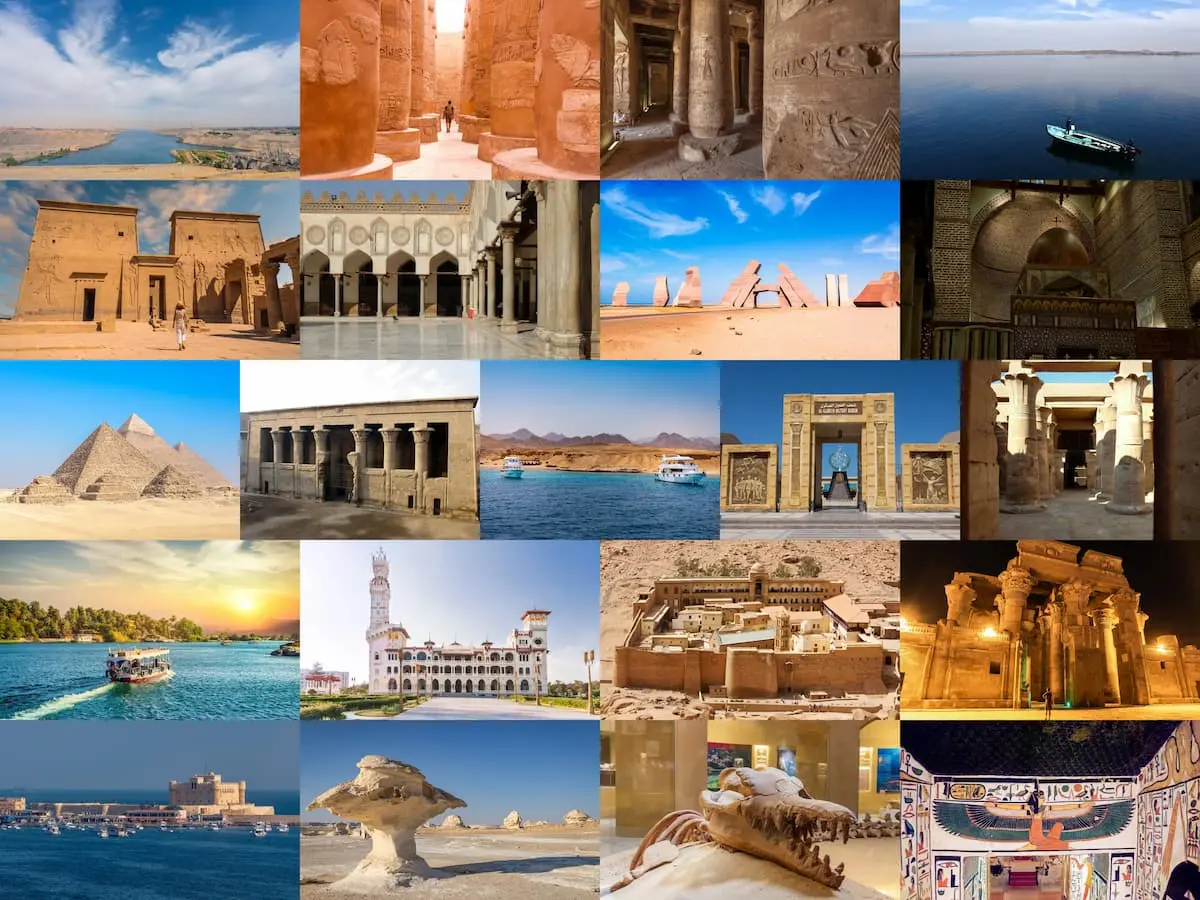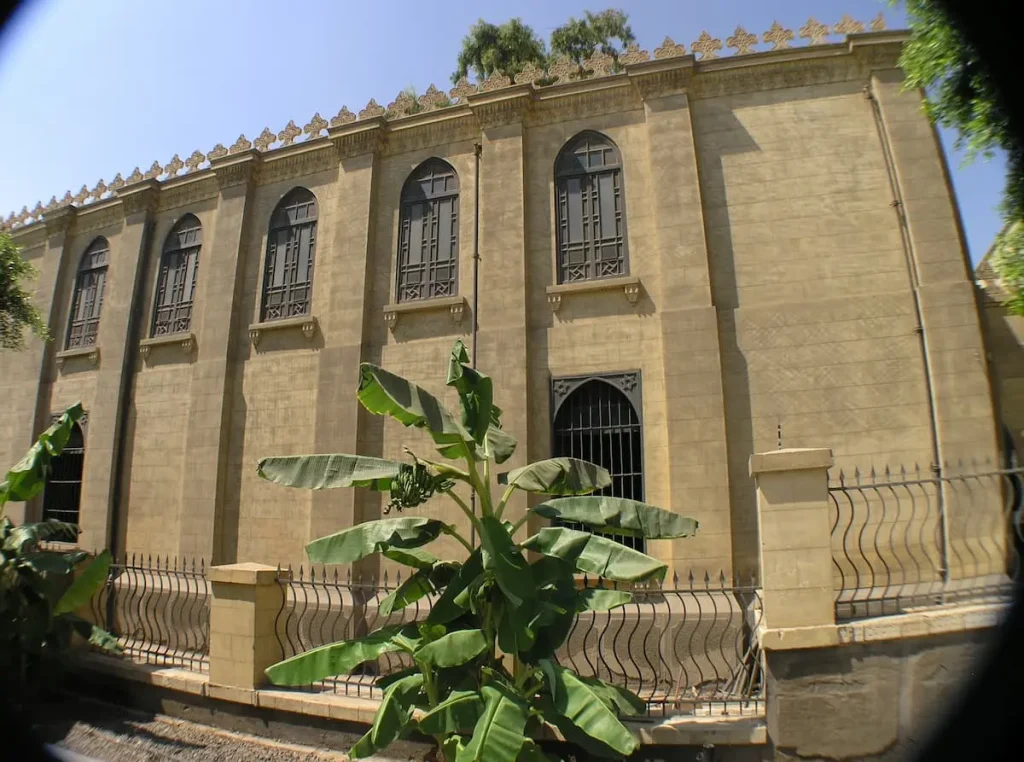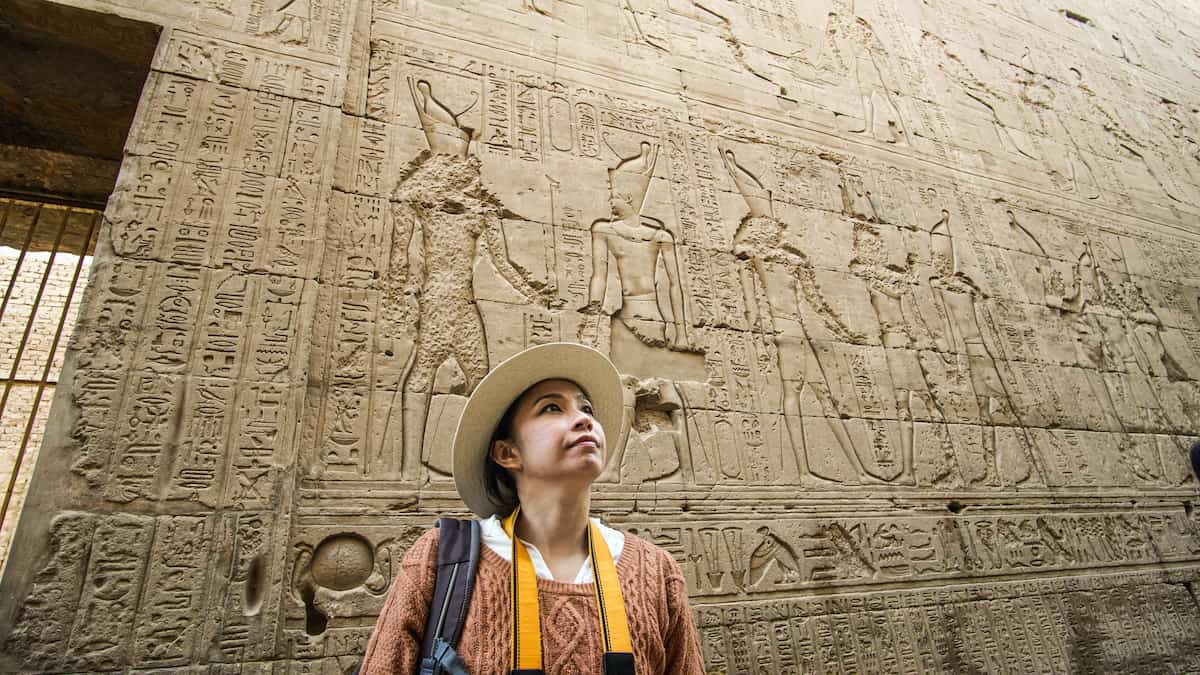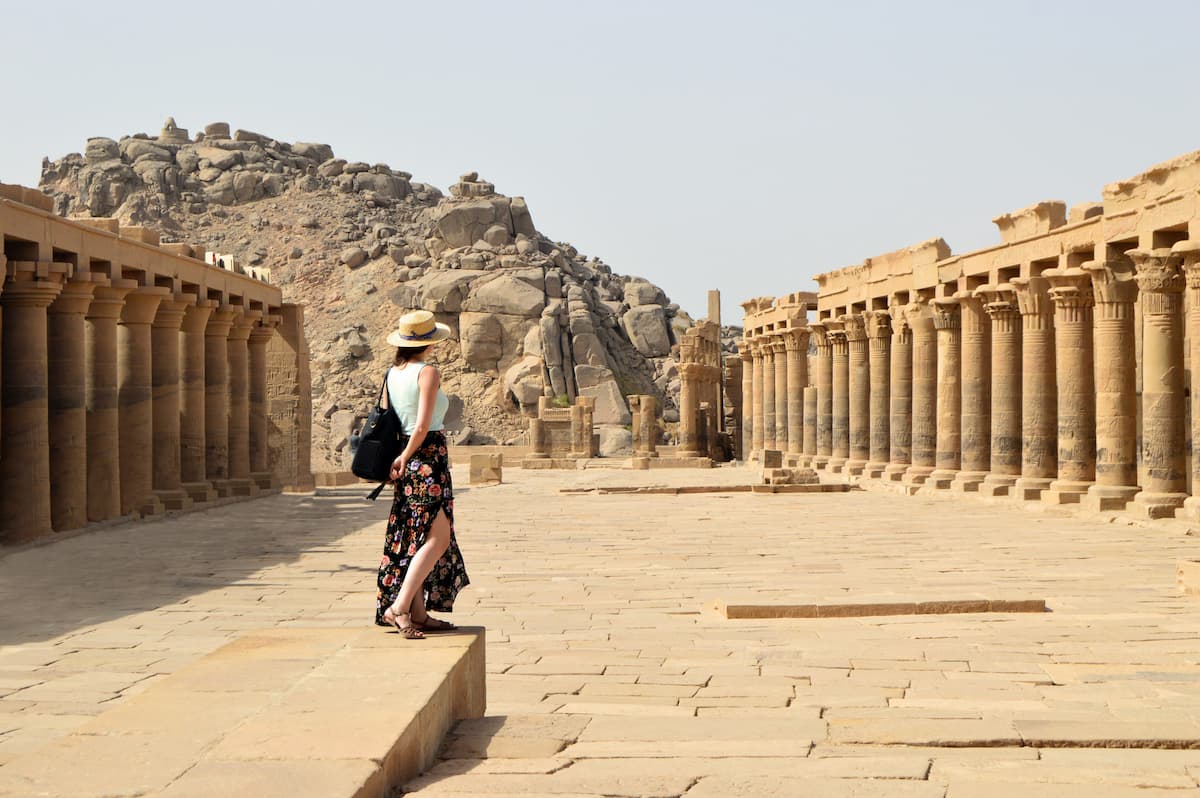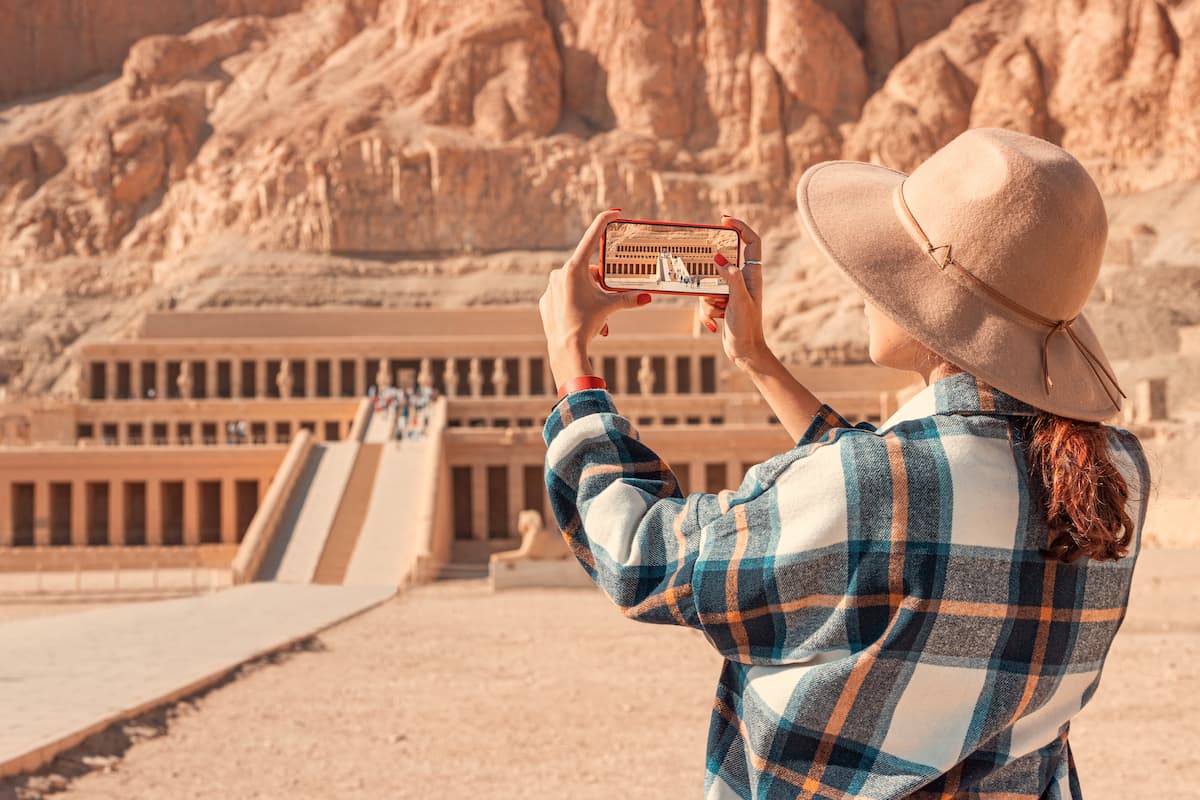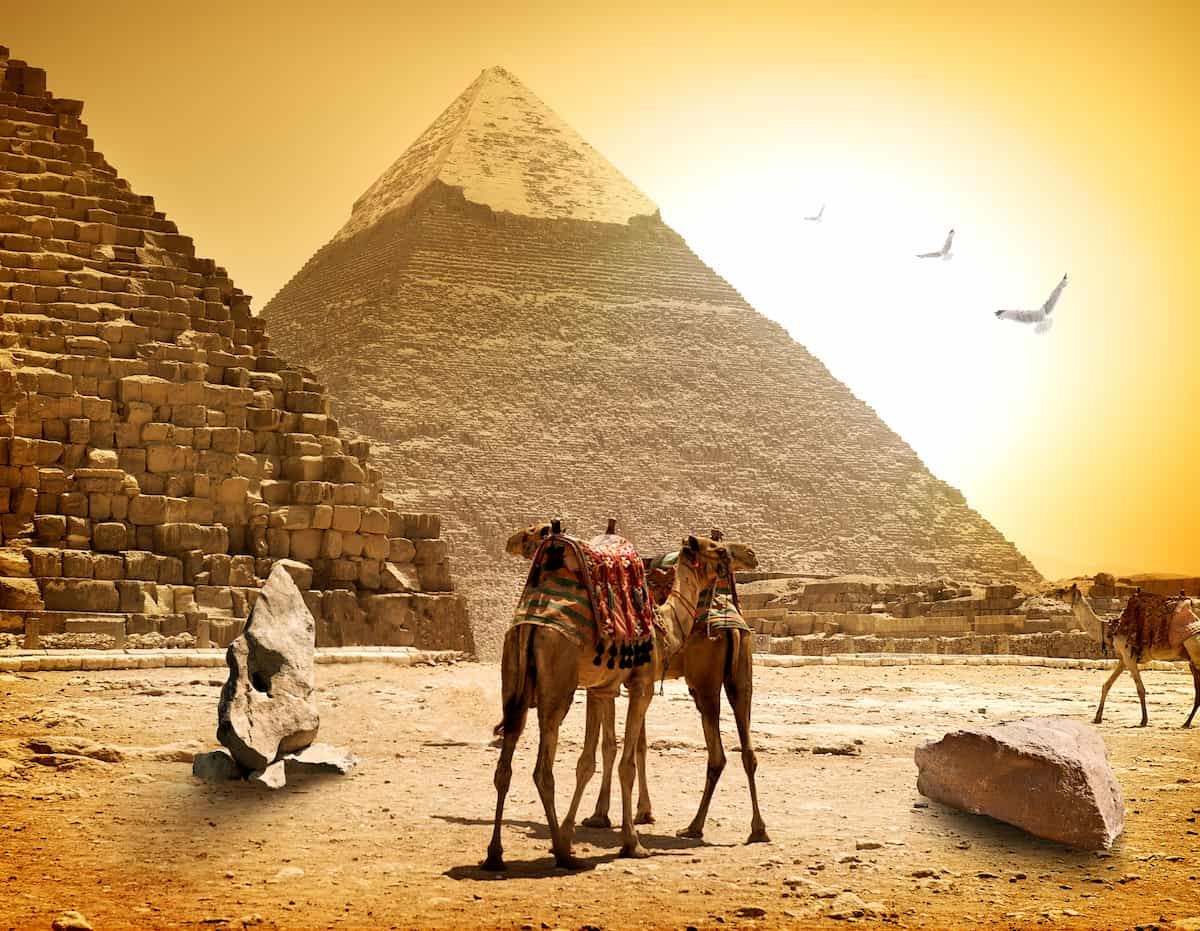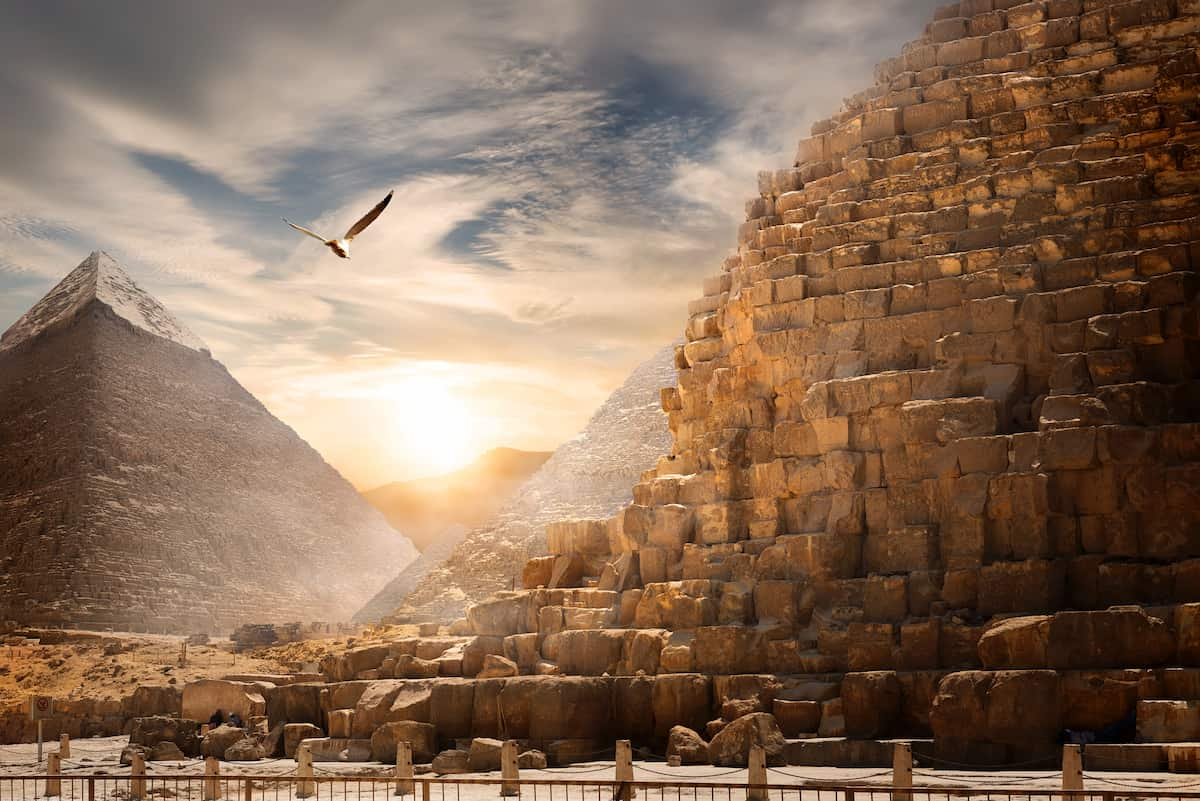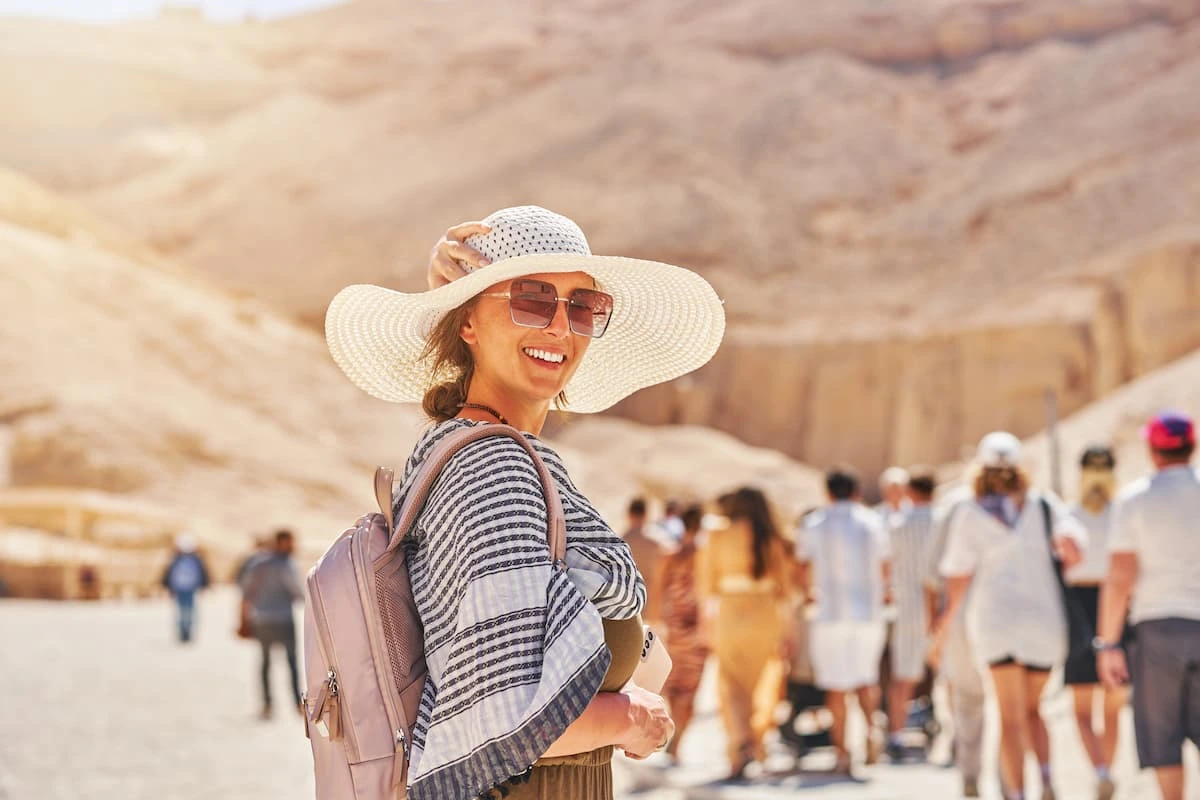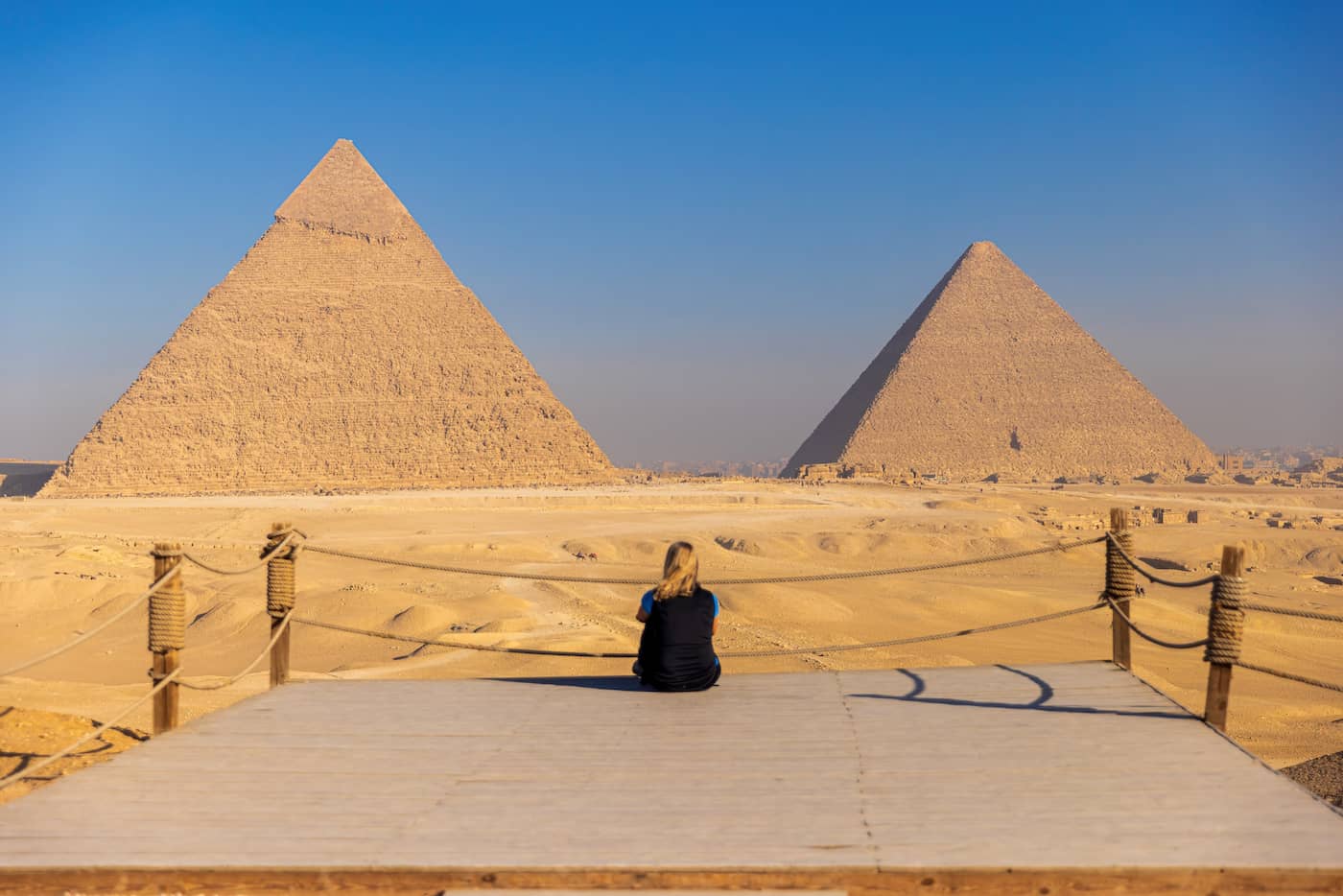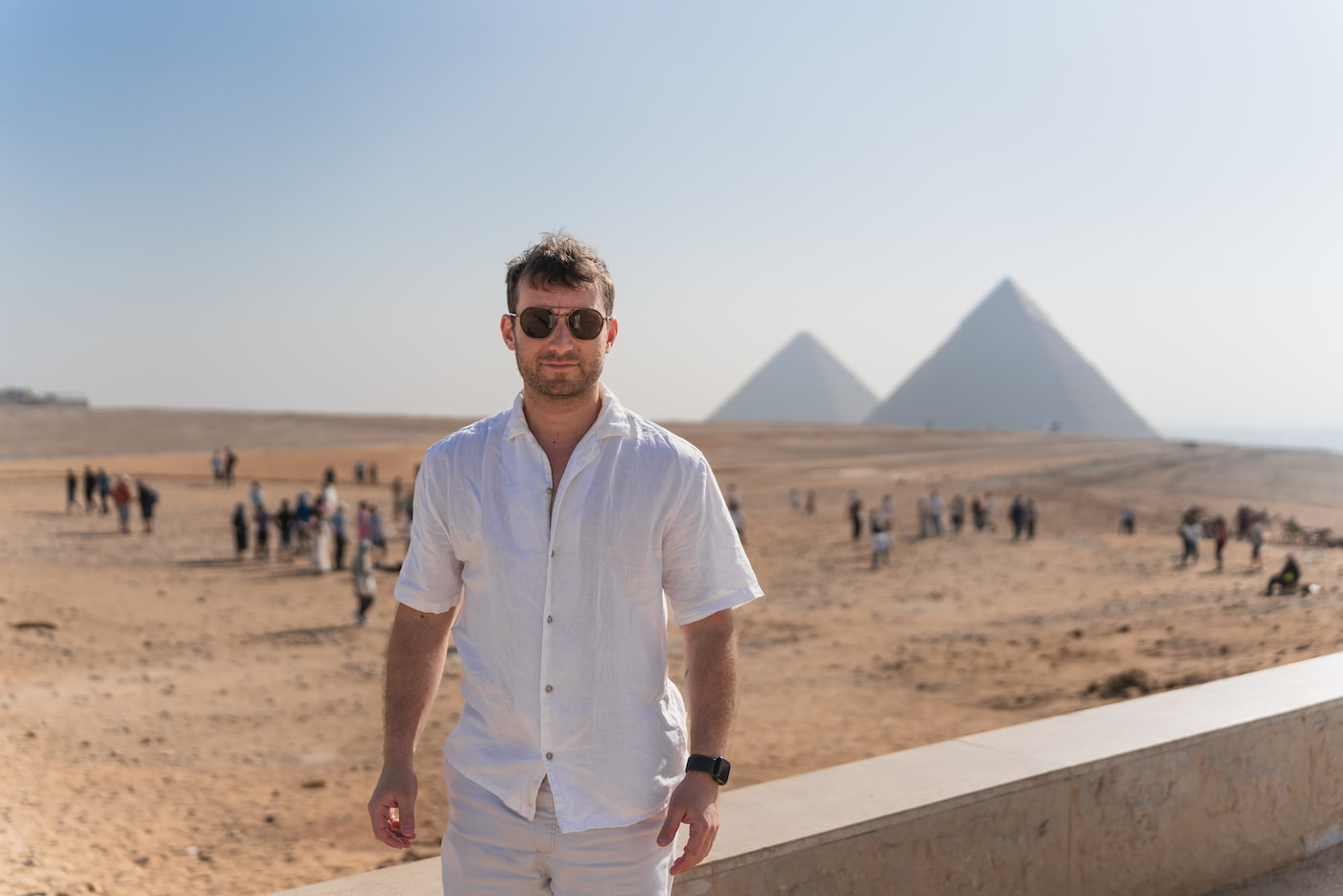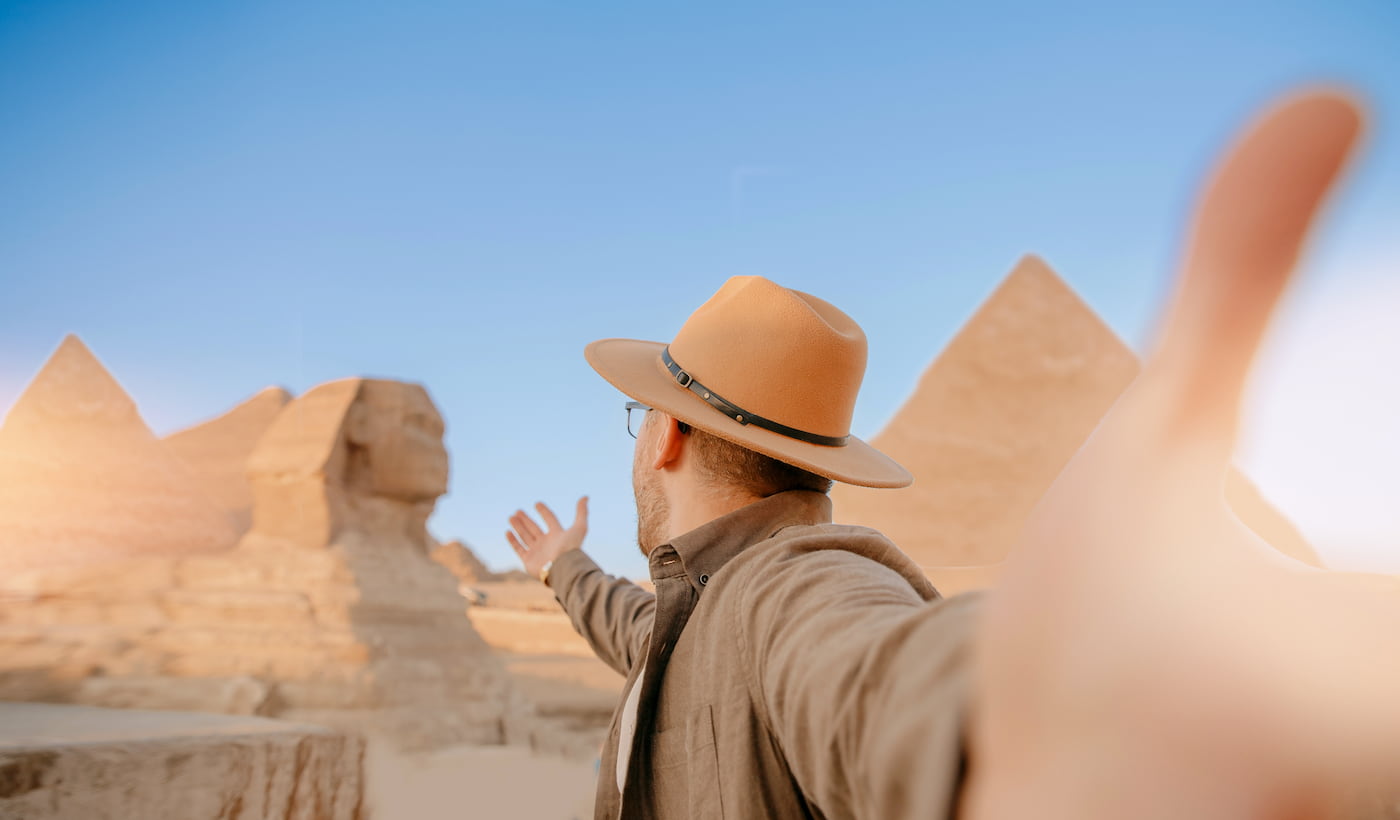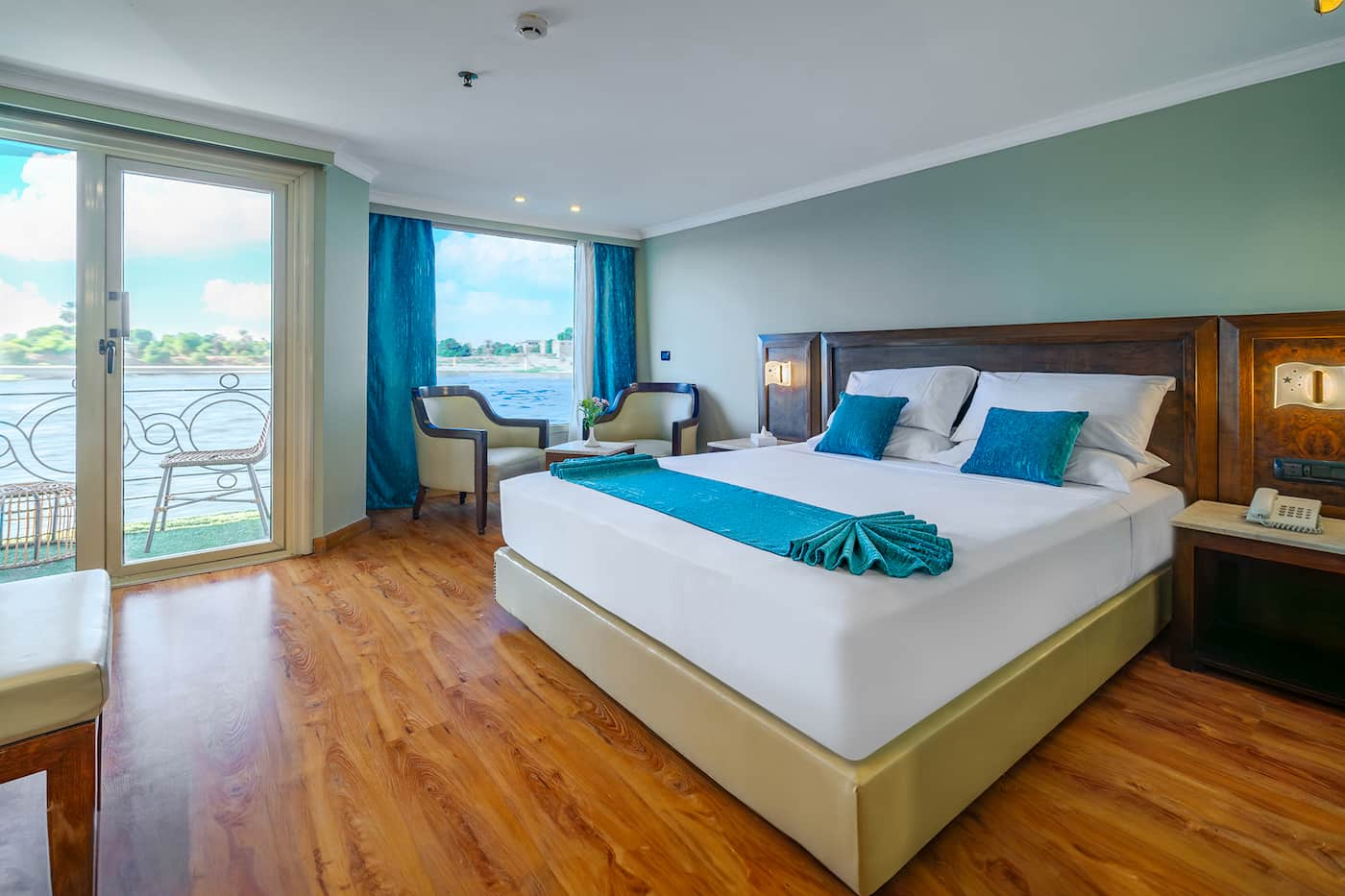49 Must-See Landmarks in Egypt: Pyramids, Temples, Monuments & Natural Wonders
What an insane mix of ancient wonders, cultural treasures, and natural scenery constitutes the Egyptian land. Egypt Landmarks and Attractions, being such an eternal country, must, by law, contain some of the world’s finest historical sites: How spectacular the Pyramids at Giza are! How awe-inspiring is the Valley of the Kings? And how well preserved are the Temple of Luxor and Temple of Karnak? One could walk beneath huge monuments, gaze at elaborate hieroglyphics, and stand on the soil where great pharaohs once thrived.
Forbes reports that apart from ancient sites, the country is also graced by splendid examples of Islamic architecture, Coptic churches, and colorful bazaars lying at the city’s heart in Cairo. Spiritual places such as the Mosque of Muhammad Ali, the Hanging Church, and St. Catherine’s Monastery are yet another layer that sings the song of spiritual diversity for the country.
Stunning landscapes are equally attractive to nature lovers. With the Nile flowing through with gleaming waters, the chalk formations of the White Desert appear quite surreal, the still waters of Siwa Oasis, and who wouldn’t love the brilliant marine life of the Red Sea, with Ras Mohammed National Park shadowing it?
In honor of Countrywide Eglandic treasures, pop into these 49 Landmarks Every Visitor Should See in Egypt. Badly needing a storm of pyramids, temples, and monuments from every nook and cranny of the country. The more one is into adventures or history will even love this list, whereas the first-timer will find these sights the best offers from Egypt in both present and past for a lifetime experience to treasure.
Ancient Egyptian Landmarks and Attractions
-
1- Pyramids of Giza
Examples of architectural engineering, the Pyramids of Giza, are without doubt some of the best architecture in Egypt. They are essentially pilgrimage sites for tourists. You will see the Great Pyramid of Cheops, also known as Khufu, the Pyramid of Khafre, and the Pyramid of Menkaure. On the list comes only the Great Sphinx. These pyramids are the result of an effort that took place over 4,500 years ago, ones that prove the engineering talents of the engineers designing in the past for Egypt, and they are one of the last wonders of the ancient world still preserved.
The entire stone structure is present here in Meroe. There could be directions allowed for roaming, granting entrance to one or two of the pyramids that could be visited according to the catalog and history, which would indeed come out after guided tours within them. A photographer’s paradise because all this is during great views of sunrise or sunset on the surrounding plateau, the Pyramids of Giza draw maximum tourist numbers every year from every corner of the globe, and Egypt’s unique landmarks.
The experience that is so fantastic in the Pyramids of Giza is deep within the cultural heritage of Egypt, if you are quite inquisitive about ancient architecture and Egyptian history, or one of the most awesome monuments ever made.
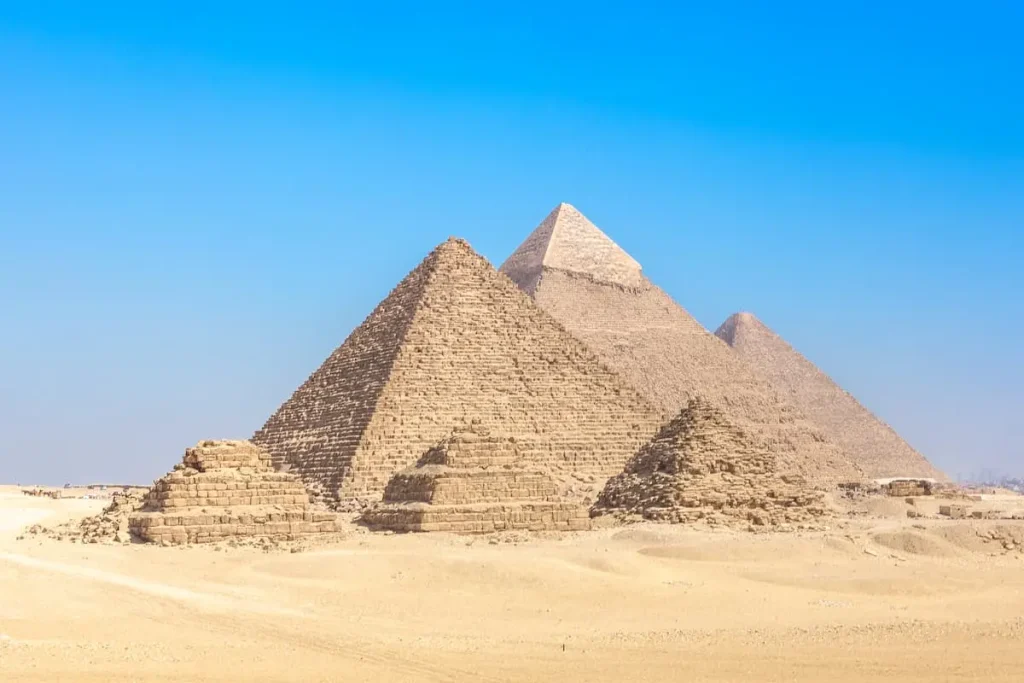
-
2- Great Sphinx of Giza
One of the most famous symbols of Egypt is the Great Sphinx of Giza, a must-see near the Pyramids of Giza. This enormous monument is a gigantic limestone statue that depicts the combination of body lion and head of human head. The previous guess is believed to be that of King Khafre, and it has stood vigil over the past 4,500 years on the Giza Plateau.
It is a very remarkable example of the ancient art and construction of about 73 meters in length and 20 meters high. From the precision work of the face to the surroundings of the plateau, it is very well possible to visit and go through the myths and legends related to it.
The gateway of one of the greatest Egypt landmarks and attractions is concerned with what lies behind the Great Sphinx. It is not only that it represents the greatness of the former symbols of Egypt, but also an entrance for having insights into the splendid history and cultural values of the country. It has given birth to many myths and stories, and works as a medium with the Great Pyramid of Giza for people who would love to feel the grandeur or extravagance of ancient Egypt in person.
Photographers and art historians are often captivated by its grandeur, and more often by its air of mystery, while wandering about and visiting Cairo.
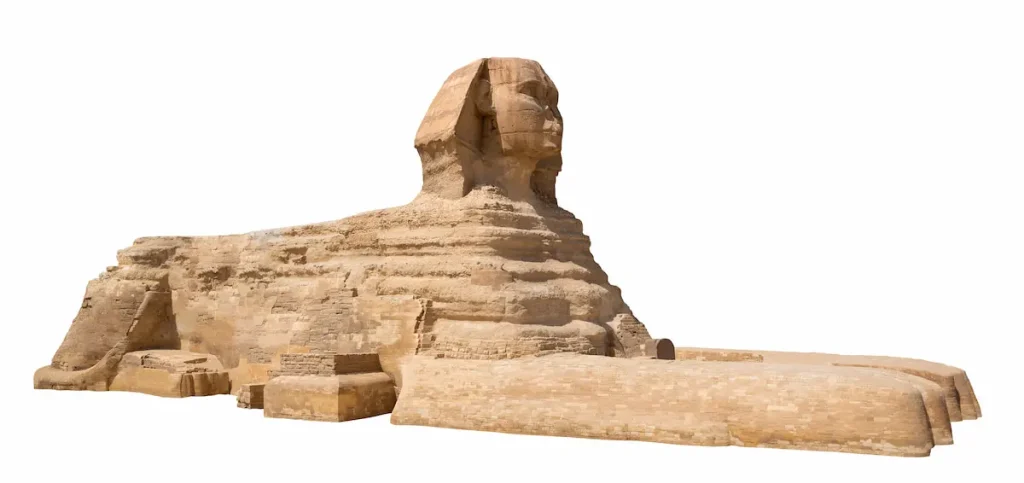
-
3- Saqqara Step Pyramid (Djoser)
These are some of the first pyramids built in Egypt. They are often considered the most famous and oldest after the Step Pyramid of Saqqara, built for the pharaoh Djoser. It is located in the northwest part of the Saqqara necropolis to the south of Cairo, probably the most famous ancient landscape of architecture of pyramids in Egypt; it is identified as the very first stone pyramid from Egypt, and a gigantic leap forward in terms of the way ancient Egyptians used construction techniques.
It has been designed by the renowned orthopedic surgeon Imhotep; the pyramid features a one-of-a-kind stepped construction. This caused the source for smooth-sided pyramids after this one in Giza. It can be visited by someone to walk around the surrounding burial complex, check out intricate corridors and chapels, and get an idea about the very early pattern of funerary and religious beliefs in ancient Egypt.
Saqqara, which features the Step Pyramid, is one of the prominent historical sites of Egypt. It conveys an evolution in pyramid design and marks the grandeur primarily in the early days of the Egyptian dynasties. Significance of history and relief of desert hop is all you need to check if you are an enthusiast of history studies, a lover of archeology, or simply a traveler who would want to see one of the first events of humankind’s development in monumental status.
Exploring Saqqara is generally quieter than Giza, as a less crowded attraction, showing Egypt’s famous ancient engineering and cultural heritage.
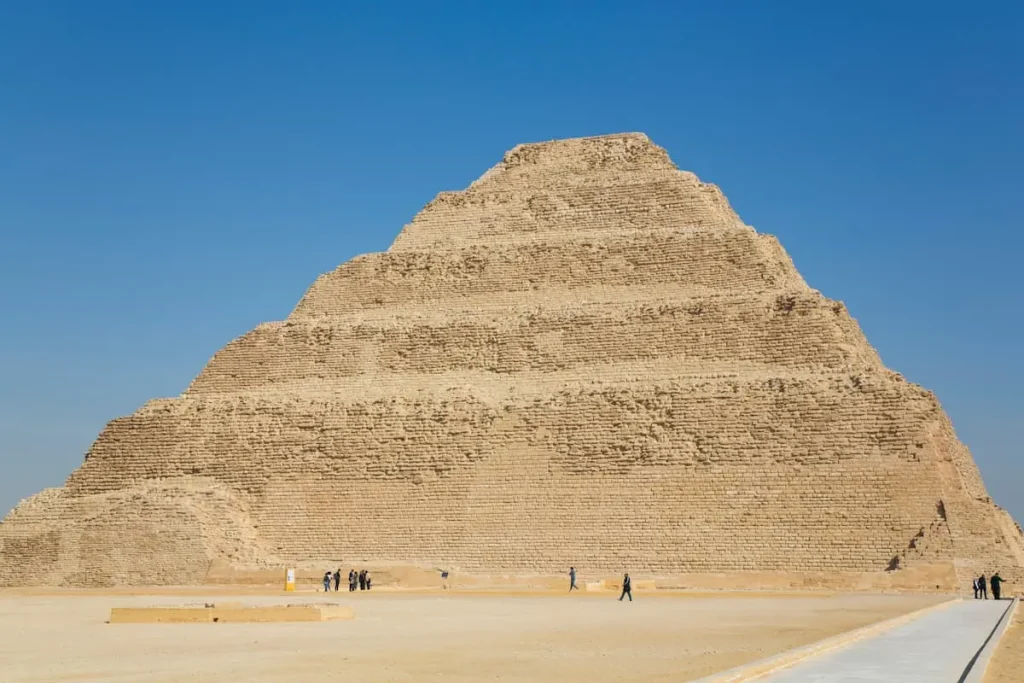
-
4- Meidum Pyramid
Meidum Pyramid is a compelling historical site in Egypt that illuminates the development of pyramid construction. Placed near Meidum, and south of Cairo, this pyramid was originally built by Pharaoh Huni, and later completed in favor of Sneferu. Its design uniquely represents how the evolution of pyramid construction, drawing back to the earlier step pyramids, still shows the smooth multidimensional structure seen at Dahshur and Giza.
Though collapsed to some extent over the centuries, the Meidum Pyramid remains as an imposing construction, impressing spectators most with its magnitude and historical significance. Apart from that, a complete complex surrounds this pyramid, including grave chambers, temples, and ruins that give an insight into ancient Egyptian architecture and the royal funerary practice.
The Meidum Pyramid in Egypt is one of the few Egyptian landmarks to attract tourists because it gives a good window into the experiments and talents of the early pyramid builders of Egypt. It is less busy than the Giza Plateau, and it is intended for any history fan, photographer, as well as someone who would want to experience the past that is over 3,000 years old.
Going to the Meidum Pyramid allows you to see one of the critical periods in the formation of ancient Egyptian building art as the step pyramid evolved into the grand, smooth-sided pyramid to come.
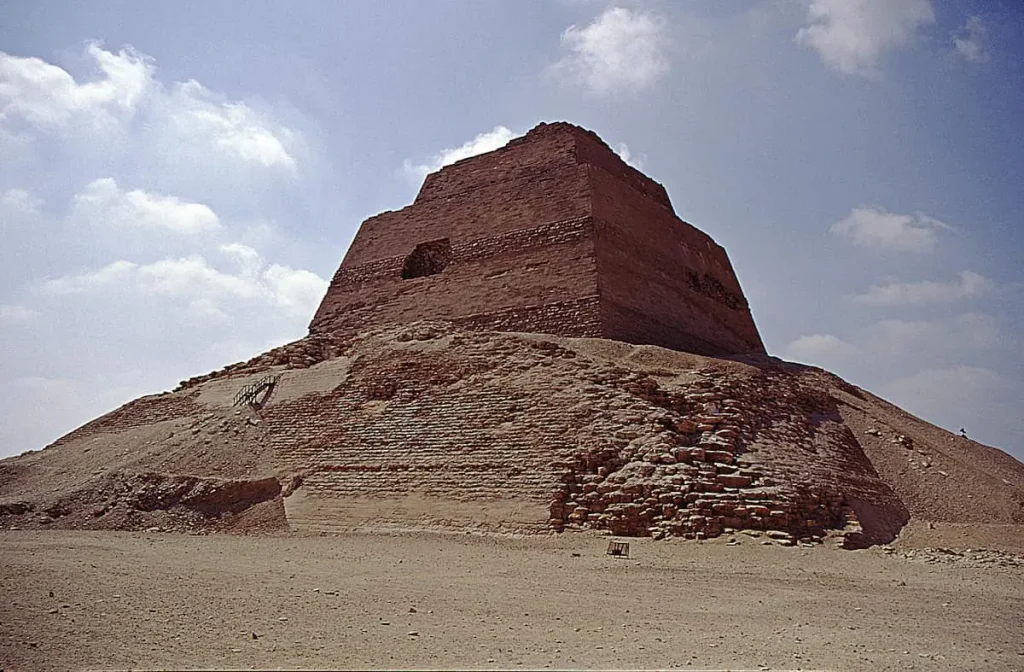
-
5- Dahshur Bent Pyramid
The Dahshur Bent Pyramid is one of the most remarkable landmarks of ancient Egypt and shows the experimentation that was taking place in pyramid construction under the reign of Pharaoh Sneferu. Its name comes from a very visible change of angle situated at midpoints that gives it its impact, particularly the “bent” effect.
This pyramid is very much of a halfway house in terms of constructional development, bridging the older step pyramids, as, for instance, at Saqqara, and the subsequently very smooth-sided pyramids of Giza. Intrepid visitors can tackle Dahshur’s internal passageways, chambers, and surrounding compound to engage in early Egyptian principles of engineering and religion.
Many good reasons can be given for including the Bent Pyramid in a tourist itinerary, without a doubt one of Egypt’s most breathtaking historic buildings. Bordered on just about all four sides by more contemporary rural farms and an outlying sprinkling of native villages, this is a peaceful traditional spot away from the large crowds at Giza.
A human editor would dream this up: Normally, one would think that these developments would not be affected except where the change would be accompanied by a relevant shortfall, but it cannot be denied by a two-factor analysis.
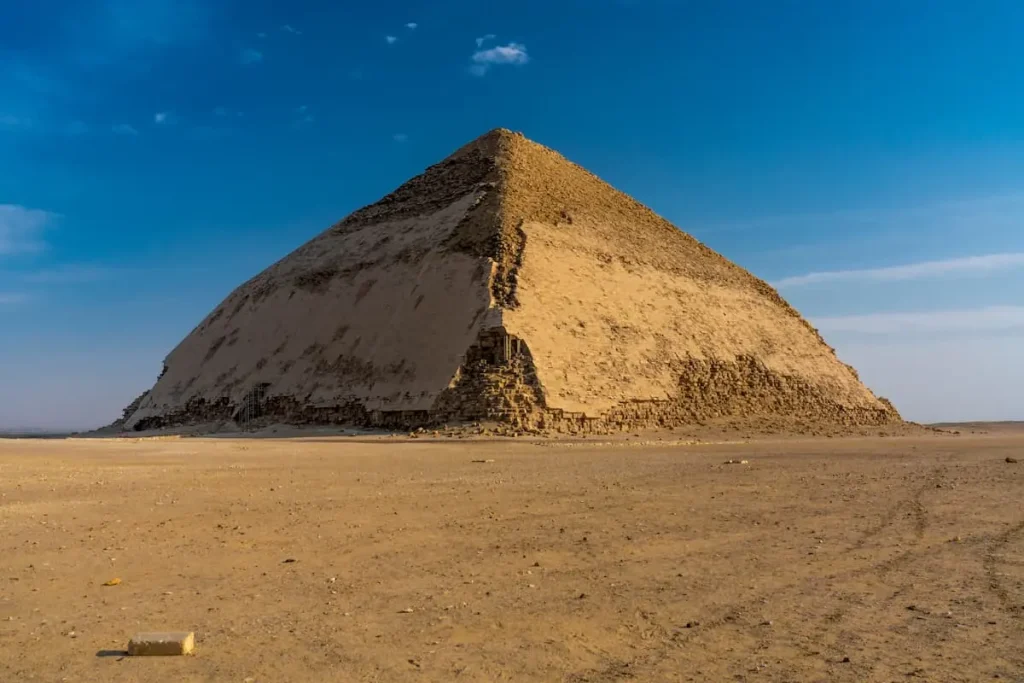
-
6- Dahshur Red Pyramid
The Red Pyramid of Dahshur is a remarkable monument that was built in ancient Egypt; it was the first “smooth-sided” pyramid to be entirely successful in building. Found in Dahshur, quite near Saqqara, it all began when it was excavated during the Old Kingdom reign of Pharaoh Sneferu; the blocks of red-hued limestone eventually came to give the pyramid its name.
Precisely parallel sides run on the Red Pyramid, in sharp contrast to the slower-to-taper, steeper incline of the nearby Bent Pyramid. This work was pretty far ahead of anything else known in its time and also surprisingly more secure. The entire pyramid is large, quite inviting, and allows loads of room in which to move.
As indeed a key Egypt historical place visited and its greatest attraction, the Red Pyramid could be seen as an example of the ingenuity and skills developed by early pyramid builders. Thus, it becomes a more peaceful alternative to the overcrowded Giza Plateau. Its architectural perfection and historical importance have placed it on the list of things that are a must among fans of history and archaeology, or any traveler interested to learn first-hand.
About the Old Kingdom, the Red Pyramid of Dahshur is valuable not only to Egypt but also to the study of the innovative advancements that would shape and drive those that finally rose in Giza.
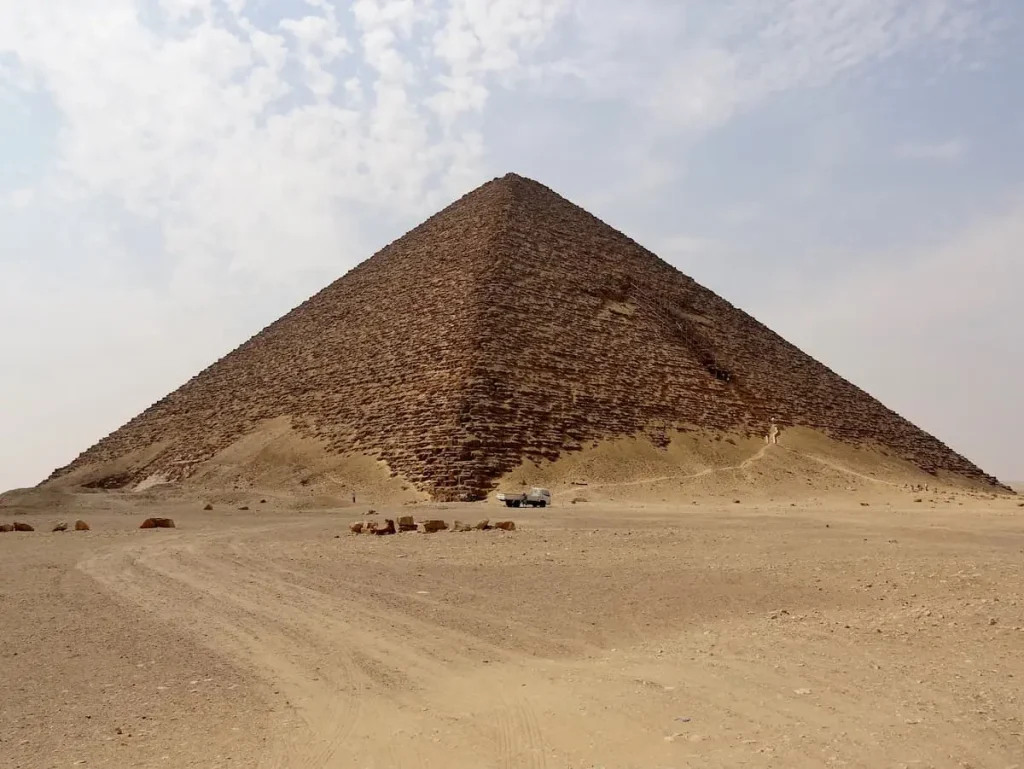
-
7- Luxor Temple
Located on the east bank of the Nile, the city of Luxor holds within it one of the greatest stage sets known to the world of ancient Egypt: the Luxor Temple. The temple can be attributed to Pharaoh Amenhotep III, and treatments were carried out during the time of Ramses II. This temple was dedicated to the Theban Triad Amun, Mut, and Khonsu, the celebration of the Opet festival that is considered most propitious for royal participants, as divine kings exercised the culture of pouring mystery between Uraeus and the spectators for relatively short periods.
Though you do not have an almost holy temple such as in Egypt, the Luxor Temple was not dedicated to any deity but was built for the greatest ceremonial crowning or purification ceremonies, and for celebrations and festivities that were of importance to the king. A spectacular entrance, marked by the presence of giant statues of Ramses II and an old obelisk, leads into a long, exhibited corridor of very impressive columns and intricately carved walls.
Truly, as saying “one of the significant cultural landmarks of Egypt and its place of tour, Luxor Temple is visited to catch quite impressive perspectives on the architecture, artistry, and religious traditions associated with that temple dating from the New Kingdom.” But if not for beauty, the best suggestion is to go at night and observe the lighted-up place giving off a kind of monument-like aura of relief to the ancient temple, leaving to uplift the soul.
It runs along the Avenue of the Ram-headed Sphinxes. Luxor Temple is one part of such a large temple construction going on as the complex of the Karnak Temple, making it one among the sprawling lines of networks of some of the biggest and most important temples.
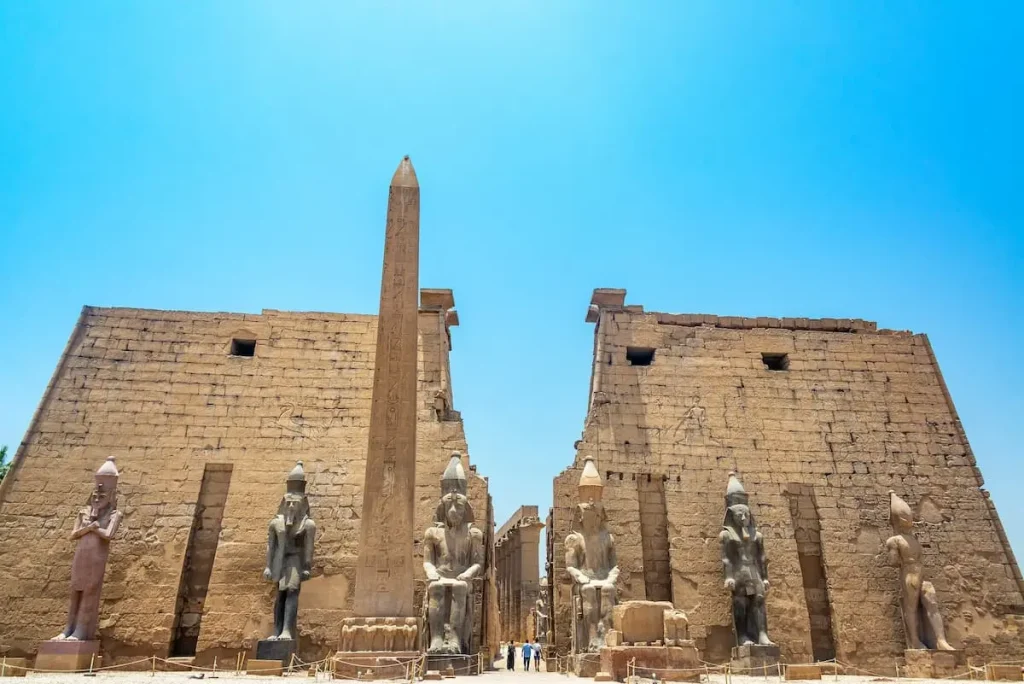
-
8- Karnak Temple Complex
Karnak Temple Complex is among the greatest religious complexes worldwide, and it is located in Luxor and flanks the Nile’s East Bank. A parcel measuring more than 200 acres, Karnak was the principal cult center of the Theban Triad, comprising Amun, Mut, and Khonsu. There was also the temple built by Ramesses II, as well as his majesty’s co-laborers, such as Hatshepsut and Thutmose III, which was further subjected to reconstruction at a later date.
Its repute rests wholly within the vastness of the Great Hypostyle Hall, imagined by 134 gray pillars of towering sandstone featuring engraved hieroglyphs and scenes of sacred ritual in material form. A few of its more interesting areas include the pyramids of Menkaure, giant obelisks, a beautiful sphinx avenue, and extensive seating areas.
The Karnak complex not only offers attractions in Egypt. Instead, it stands as a faithful mirror of power relations that existed among most political, spiritual, and artistic elites of the New Kingdom itself. This place was not identified only as a temple, but was a very extensive city for ceremonies and processions of festivals and royal declarations.
It is commonplace for one to go on a visit to Karnak side by side with Luxor Temple, both interconnected through the newly repaired Avenue of Sphinxes. Those who enter the precinct of Karnak are likely to follow the footsteps of their ancestors along with the long-ago priests.

-
9- Valley of the Kings
The site of the famous Valley of the Kings has often been said to be among archaeologically significant sites in Egypt and is located not far from Luxor in West Thebes, across the river to the east. It is historic as the royal burial place for the pharaohs of the New Kingdom (16th–11th centuries BCE) and the nobles and high priests 60 rock-carved tombs.
At the heart of all of these, without any doubt, at the most noteworthy excavations of the past century, we can establish the terms of the grave. Howard Carter found all the treasures of Tutankhamun, who is the most famous in the tomb in which the “boy” pharaoh was entombed in 1922.
Moreso, others such as Ramses II, Seti I, and Thutmose III have splendid reliefs of religious texts and iconographies to afterlife activities as well as protecting deities. One gets to know the site, for the people visited so far, now it has become an important site with evidence given on its layout. His tomb forms the limits of the Valley of the Kings, for which one must go, beside at the same time discover the efficacy and spiritual reality of ancient Egypt’s artistic accomplishment.
Furthermore, the sound context is complemented by contrasting or surprisingly quiet words related to the travelling platforms and examples of low vowel sounds inserted in the text. Defying words played with probabilities, the very example already presented above in the current snippets is ideal.
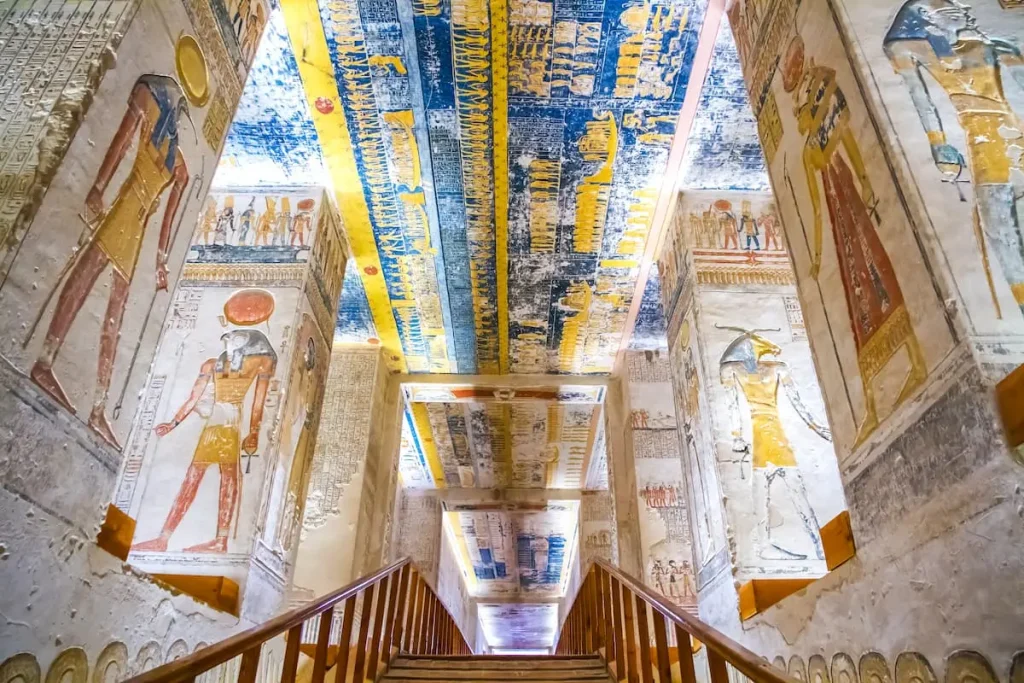
-
10- Valley of the Queens
Valley of the Queens is an important archaeological site on the west bank of the Nile near the city of Luxor, its elliptical shape bound by the encircling rock projections, housing the wives, princesses, and, most significantly, children of the New Kingdom pharaohs. In ancient terms, this became generally known as Ta-Set-Neferu or “The Place of Beauty,” where presently over ninety rock-cut tombs can be seen, their dates stretching over all or mostly all pertinent dynasties between the 18th and 20th.
The most important of these would presumably be the tomb of Queen Nefertari, wife of Ramses II; often referred to as the ‘Sistine Chapel of Ancient Egypt’ since it has some of the best-preserved wall paintings that depict the delineation of the afterlife, which are showcased in the tomb itself. Different sorts of tombs featured different colored and vivid hieroglyphs with religious texts combined with typically related portrayals of royal family figures, inclusive of protective deities.
On the one hand, it cannot be denied that this depressing country has a great deal of knowledge as well as cultural power. It is incontestable evidence that there is so much history and greatness held by such a small land.
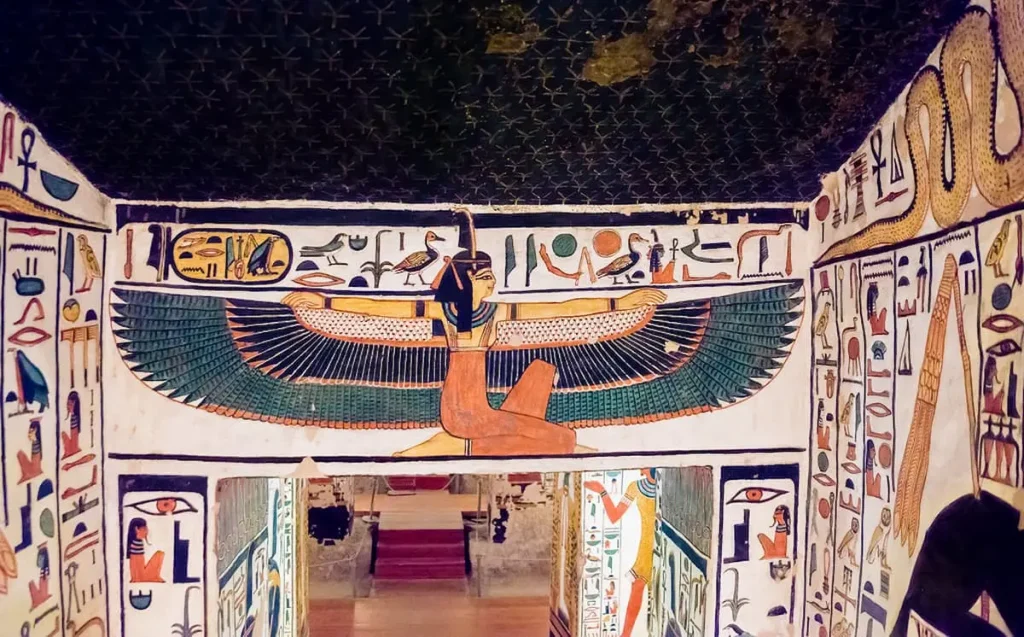
-
11- Temple of Hatshepsut
Probably the jewel of Egypt’s architectural treasures, this temple is placed on the west bank of the Nile, opposite Luxor. It is a mortuary temple built in the 15th century BCE for Queen Hatshepsut, arguably the most successful and most powerful female pharaoh in ancient Egypt’s history.
Three terraced levels joined by wide ramps with a striking design give prominence to the temple, and hewing the lower terrace from the cliff must have been a gigantic task. The walls and columns of the temple are decorated with reliefs narrating the divine birth of Hatshepsut, the trade expeditions to Punt, and various scenes of worship to the gods.
Contrary to all other places in Egypt, the Temple of Hatshepsut has remained an epitome of New Kingdom architecture and the legacy of one of Egypt’s most eminent rulers. The harmonious design and aesthetic and historical grandeur make it the crowning glory of any trip to Luxor.
With the Temple of Hatshepsut, the Valley of Kings, Valley of Queens, and Colossi of Memnon are the main tourist sights of the West Bank. Embarking there as a site against dramatic desert cliffs arguably makes it the most picturesque site in Egypt.

-
12- Colossi of Memnon
The Colossi of Memnon are two imposing stone statues set on the west bank of the Nile near Luxor. Carved from quartzite sandstone, these two gargantuan statues, each approximately 18 m. (60 ft.) tall, represent Pharaoh Amenhotep III, and were once situated at the gate of his mortuary temple that now largely perished with time.
Originating in the 14th century BCE, having been about and practiced for over 3400 years, the statues have witnessed floods, earthquakes, and countless other historical occurrences. One statue in the Greco-Roman period was famous for producing the enchanting dawn sounds, interpreted by ancient travelers as the voice of the hero Memnon, thus giving rise to the site’s modern appellation.
The Colossi of Memnon today are a popular sight to behold and embark on a quick tour, mashing the memory of Amenhotep III with history. They are usually the starting point for tours on the West Bank, just off the Valley of the Kings, Valley of the Queens, and the Temple of Hatshepsut.
Such size and notoriety inspire most to get a photo with them, firmly engraving them in memory as a representation of the enduring architectural residence of Egypt.
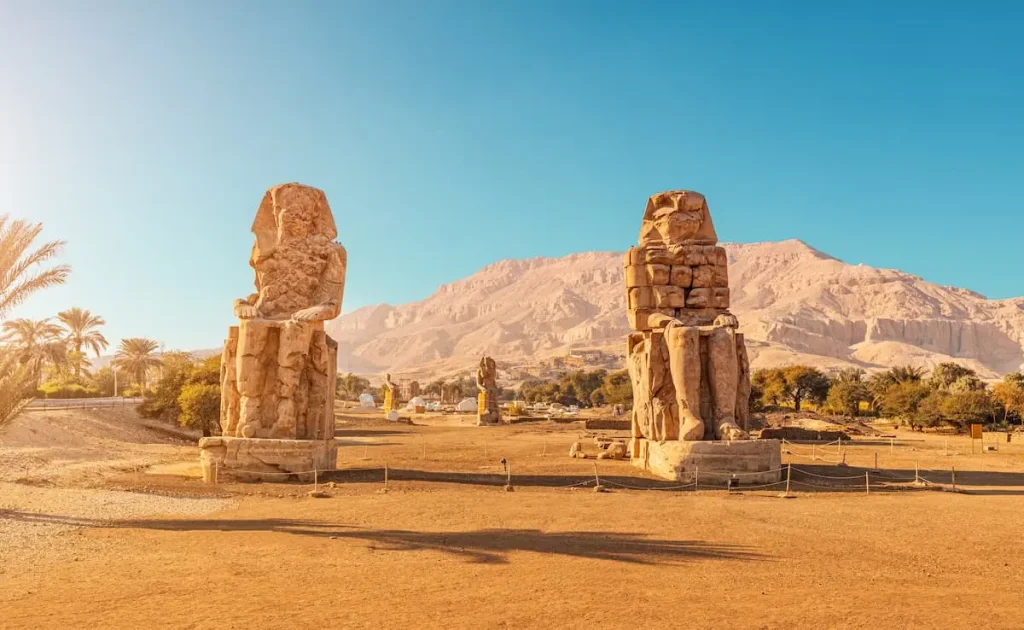
-
13- Medinet Habu Temple
Perched on the West Bank of Luxor, the Medinet Habu Temple remains one of the best surviving temple complexes in Egyptian history. Formally known as the Mortuary Temple of Ramses III, it emerged in the 12th century BCE to witness worship and act as the stage for commitment to the glorious pharaoh’s reign.
The Medinet Habu structure is framed by giant pylons that announce its presence via towering walls and reliefs that detail military glory to include the campaigns of Ramses III against the Sea Peoples. Many of the carvings still exhibit traces of pigment, thus offering an unusual glimpse into those inspiring scenic thoughts of the New Kingdom artists in full, colorful splendor.
The inscriptions and monuments of Medinet Habu shed light on both the political and religious aspects of ancient Egypt. That is to say, they recount with some detail the economic activities, the religious rites, and the temple’s scope of influence as an administrative force.
Slightly off the beaten path compared to the other Luxor temples, Medinet Habu offers a lighter, more meditative experience. Usually, it is paired with a few other West Bank sites such as the Valley of the Kings, Valley of the Queens, and Colossi of Memnon, a must for every history buff and shutterbug alike.
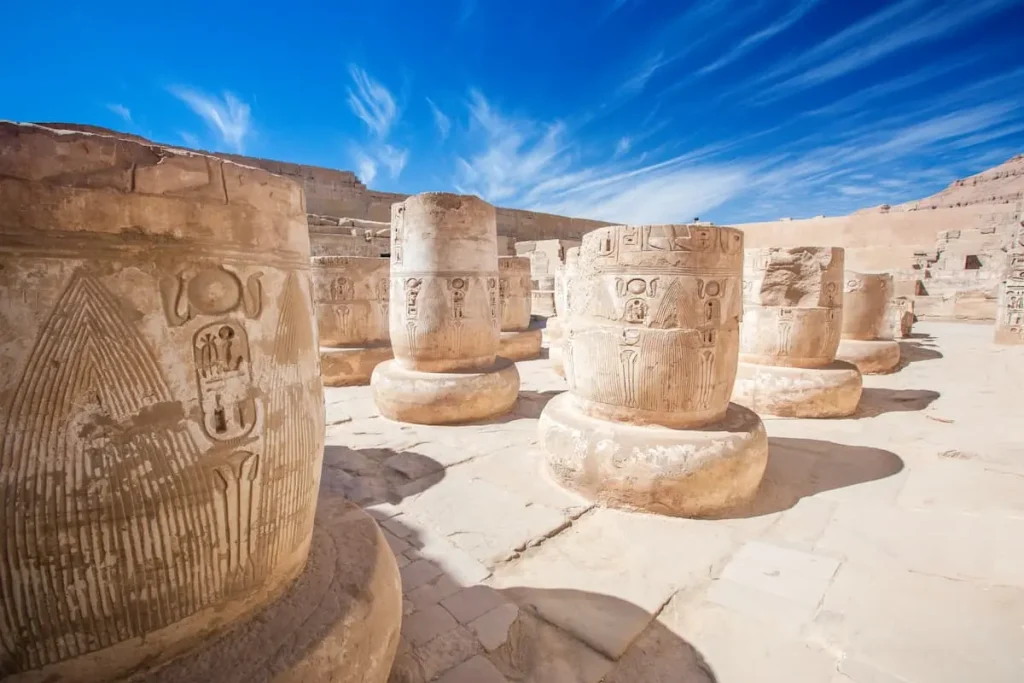
-
14- Ramesseum
It is a known funeral temple for the Egyptian Kings of old, one of the best of the Ramesseum monuments on the West Bank of Thebes. This is the place where one of the mighty pharaohs of the New Kingdom, Ramses II, has his memory in the Ramesseum. Built by the king and under this best Egyptian architecture, the temple here at Ramesseum was one of the monuments that was dedicated to the foreverness of name of King Ramses II when he was ruling his empire in the thirteenth century BCE.
It is the colossi people normally associate with the Ramesseum. Every one of them says maybe the colossus of Ramses II sundered, a colossal grandeur among the ruins, the vision the poets, such as Shelley, and travelers saw with awe through the ages. Percy Bysshe Shelley said it best in his famous poem “Ozymandias” when he paid homage, inspiring awe, to the mind-blowing sight of the colossus. Inside are paintings of battle scenes, rites of religious character, and proof of the divine relationship between the pharaoh and deities.
At this point in human history, fashion doesn’t make any sense. The other exceptional case is congested highways, meaning traffic.
If there were any potential hazards for blind drivers, it’s generalized as whatever indication is an idea suggesting relevant proprietary conditions, cold sensitivity to such stimuli, and yet his capability for a ride over such gloomy weather.
The bright sky seemed pretty special, and behind it rolled the usual American kind of fluffy white cumulus, which seemed far too big to be true, almost alien-like in color and littered wherever the eye went. Wearing well well-saturated camel would have done the trick of being noticed at a distance.
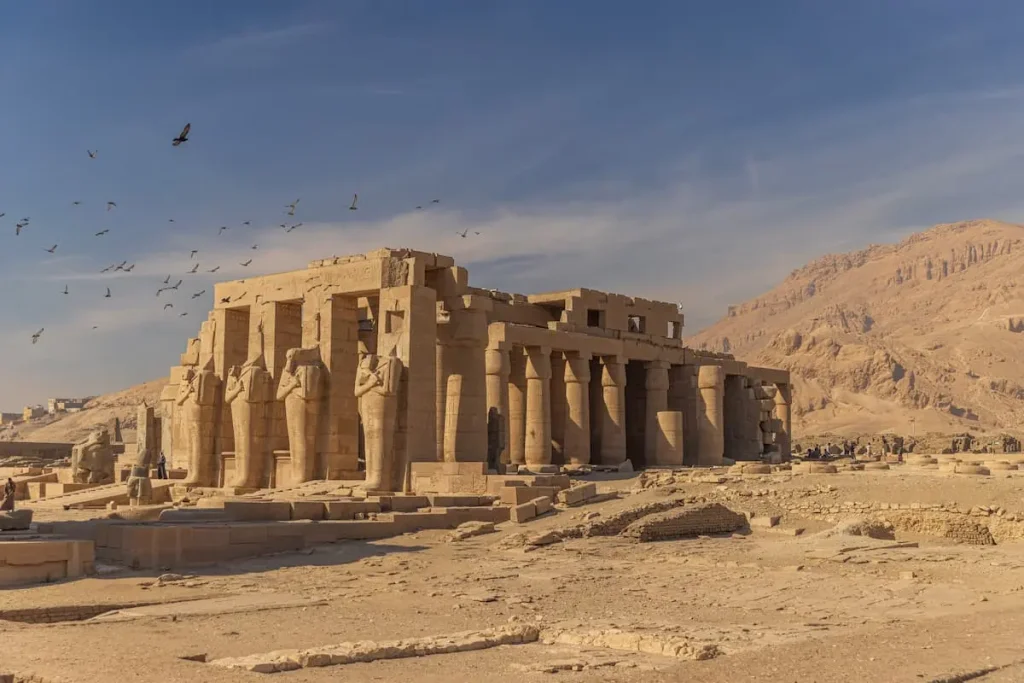
-
15- Abydos (Temple of Seti I)
The Temple of Seti I in Abydos, just north of Luxor, is one of the most remarkable spiritual monuments from ancient Egypt. It was made by Seti I, who left for his son Ramses II the project of building a temple that would bear his father’s name in glory unto all eternity. On the walls of this temple would be performed the rites of Osiris, god of the afterlife, from which Pharaoh went forth as Horus on the hyena throne.
It additionally houses the famed Abydos King List, a timeline of pharaohs structurally carved into the walls of the same temple. Some features of this place, which could be developed into some harmonic ancient technology, might include the presence of many enigmatic carvings. Many of its architectural alignments are proof of the standing of the place in history and its value to historians, archaeologists, and others.
One of the main reasons why one goes to Abydos is for the privacy one cannot find in the throngs at the temples of Luxor. When one goes to the Temple of Dendera, one then visits the Seti I Temple. Fans of history, fans of art, or any metaphysician must visit the Seti I Temple.
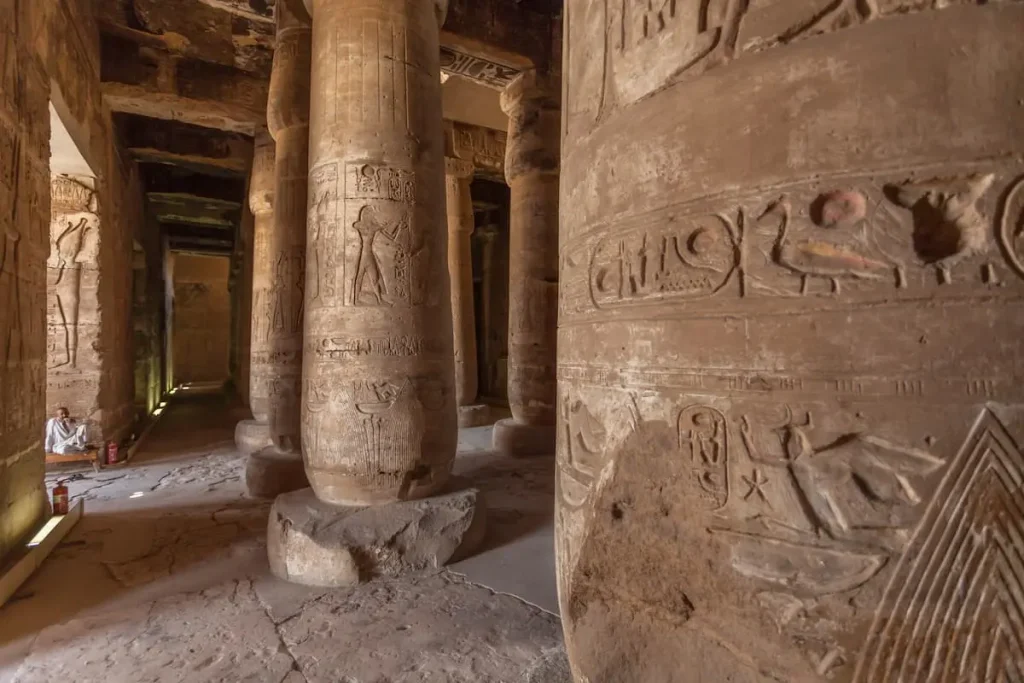
-
16- Dendera Temple Complex
About 60 kilometers north of Luxor is an ancient temple site, one of the best-preserved in Egypt. Around this mammoth complex lie four temples, which still stand alongside the bigger Temple of Hathor, considered by some to be one of the last two or three monumental temples ever built in ancient Egypt, from the late Ptolemaic to the Roman periods. It is a cosmic temple dedicated to Hathor, goddess of love, music, and pleasure, a spirit that goes well with grandeur and delight.
The temple hypostyle hall boasts a famous astronomical ceiling: zodiac signs, celestial boats, star-maps—the almost second-best example of ancient Egyptian astronomy. From here, it was also possible to enter the crypts underground, chapel roofs, and very detailed carved reliefs representing scenes of the Pharaohs offering to the gods.
The Dendera Zodiac, currently exhibited in the Louvre, came from the temple setting and thus self-evidently underlined its astronomical character. The walls of the temple still retain much color, considering they are over 2,000 years old, giving us a rare opportunity to see how very brightly the ancient Egyptians could decorate.
Apart from Abydos, the temple complex opens a huge window to Egypt’s religious, artistic, and scientific traditions, more than enough for any ardent lover of history or culture to visit!
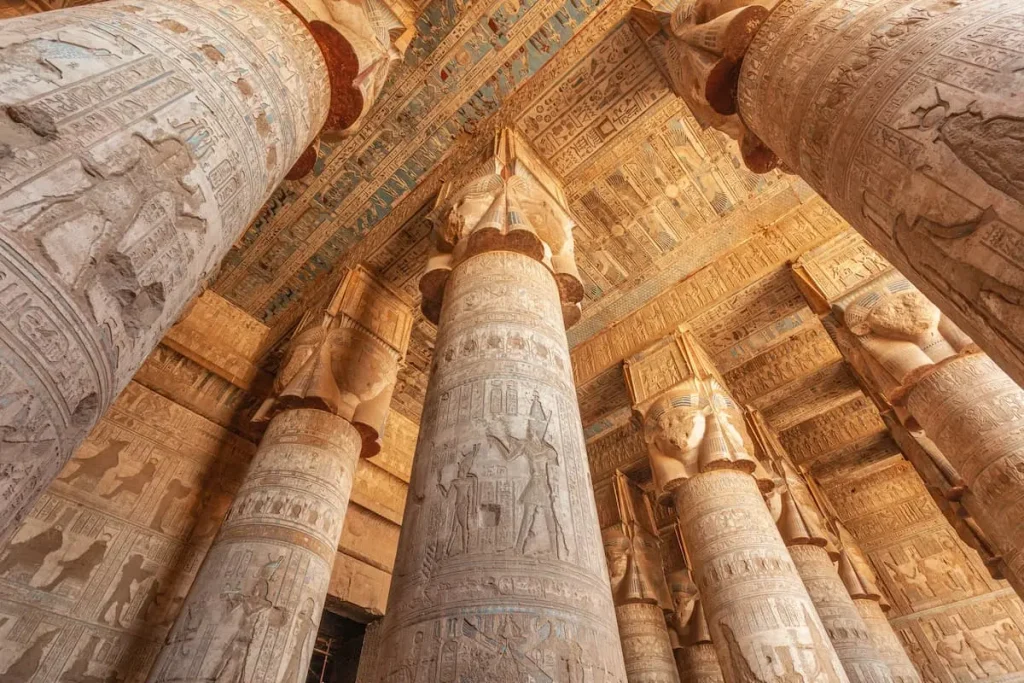
-
17- Abu Simbel Temples
Once upon a time, its shoreline was far removed from the Sudanese border, making it among the truly awe-inspiring landscapes of Egypt today. The two temples, carved out of the rock by the Pharaoh Ramses II in about the 13th century BC, were meant to establish his divine right to rule and to praise the gods Amun, Ra-Horakhty, and Ptah together with his queen, Nefertari.
Outside the Great Temple stand four giant statues of Ramses II, whatever way one looks at them, standing probably a giant 20 meters tall, silently guarding the entrance. Inside, the walls are covered with elaborately carved reliefs recording the military campaigns of the pharaoh, including those of the famous Battle of Kadesh; the smaller Temple of Hathor, dedicated to Nefertari, is just as remarkable, with statues of the queen given equal stature with those of her consort a very rare distinction in the ancient world of Egypt.
Abu Simbel Temples were also very much famous for solar alignment, whereby on the sunrise of 22nd February and 22nd October, sunlight will precisely fall on the interior sanctum of the temple. From going to being swallowed up in the reservoir of the Aswan High Dam, UNESCO saved the temples during the 1960s, thus balancing the temples as an engineering wonder, both modern and ancient.
Given the opportunity to visit Abu Simbel, travelers in Egypt get a marvelous combination of history, art, and astronomical precision to pursue.
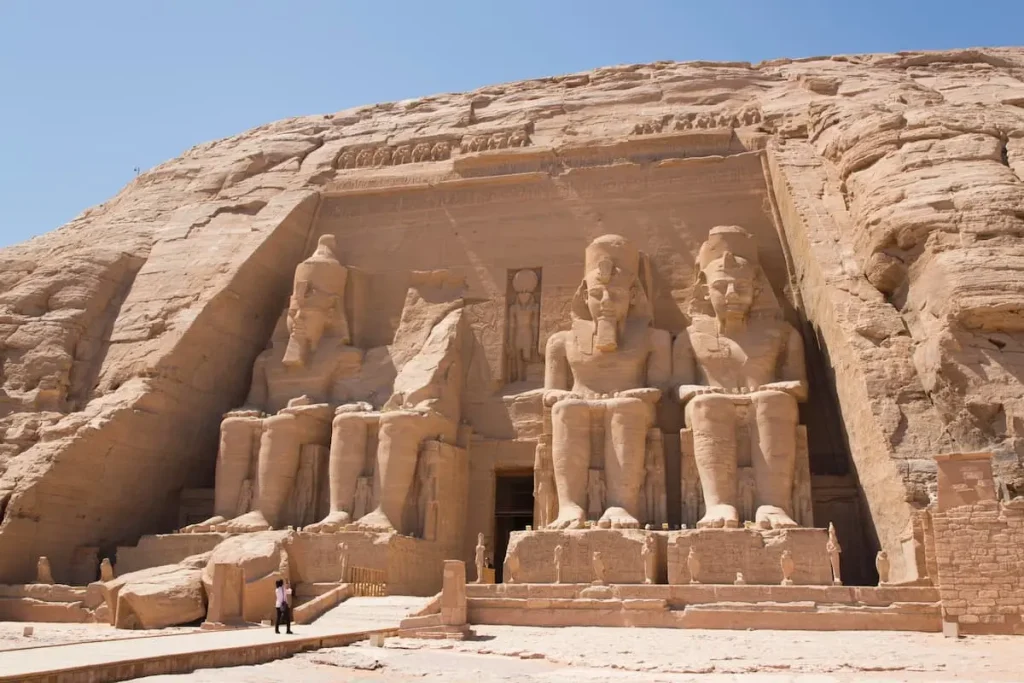
-
18- Philae Temple
The Philae temple itself has always been considered one of the most exquisite and atmospheric ancient sites in Egypt. The temple complex was erected and dedicated to the Goddess Isis in the Ptolemaic period, somewhere between the 4th and 1st centuries BCE, in a blend of Egyptian and Greco-Roman elegance.
Philae was the famous temple to worship Isis and attracted pilgrims from all over the Mediterranean world and beyond. Beginning at the impressive First Pylon, temple chambers and sanctuaries lead out into courtyards richly adorned with reliefs of mythical scenes and royal offerings, as well as those showing the goddess engaging in her well-known function in the resurrection of Osiris. Also of interest are the Temple of Hathor and Trajan’s Kiosk, a quaintly picturesque little pavilion popularly referred to as “the Pharaoh’s Bed.”
During the construction of the Aswan High Dam in the 1960s, the temple stood to be submerged. Thanks to an ambitious UNESCO rescue venture, Philae was dismantled and moved onto present-day Agilkia Island, block by block. This engineering feat of the movement of a temple has saved the temple from losing its beauty and historical significance.
A boat ride, next, in the glories of ancient monuments, sinewy poetry of ancient Egyptian and classic ways, rests at Philae, looking onto the mighty Nile. It ranks fourth among the most pleasant sites and landmarks of Egypt.
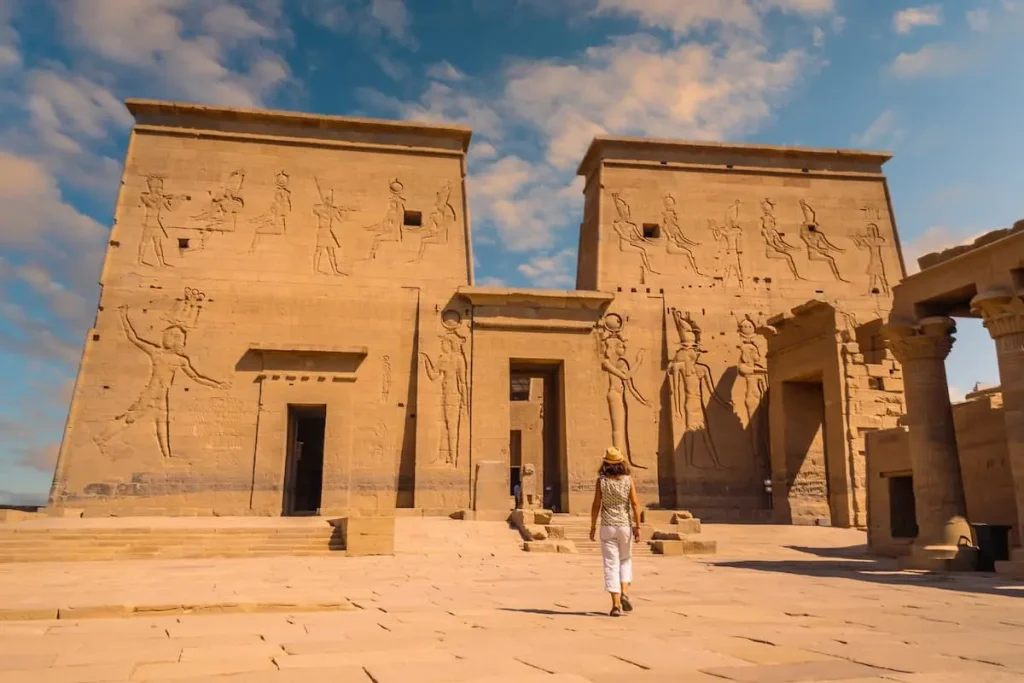
-
19- Kom Ombo Temple
The most unique and breathtaking monument of antiquity in Egypt is the Kom Ombo Temple; it is considered so due to its complete solitude. The temple sits in a pretty little bend of the Nile between Aswan and Edfu. The temple was constructed in Ptolemaic times, somewhere between 180–47 BCE, with the uniqueness that it was an equal dedication to two gods: Sobek, the god of fertility and the Nile, who was crocodile-headed; and Horus the Elder (Haroeris), falcon-headed god of the sky and kingship.
Thus, having two entrances and two sanctuaries, this temple was considered worthy of two gods; the columns and halls were constructed as mirror images of one another. The walls, upon being carved into reliefs, depict scenes wherein prizes are presented unto the gods, sights of elaborate medical instruments, and scenes of an ancient ritual invaluable in the study of Ancient Egyptian religion and medicine.
Behind the temple, the Crocodile Museum is housed, with mummified crocodiles and artifacts associated with the Sobek cult, offering insights into the lives of ancient Egyptians along the crocodile-infested Nile.
As with many temples in the Nile Valley, Kom Ombo has retained much of its glory in spite of erosion, earthquakes, and quarrying throughout the ages. For those who crave history and a view from atop the locale, it is a welcome stop during a Nile cruise.
Visiting the Kom Ombo Temple takes one through the historical backdrop of Egyptian double-god worship, mingling mythology with the gorgeous scenery of a unique site.
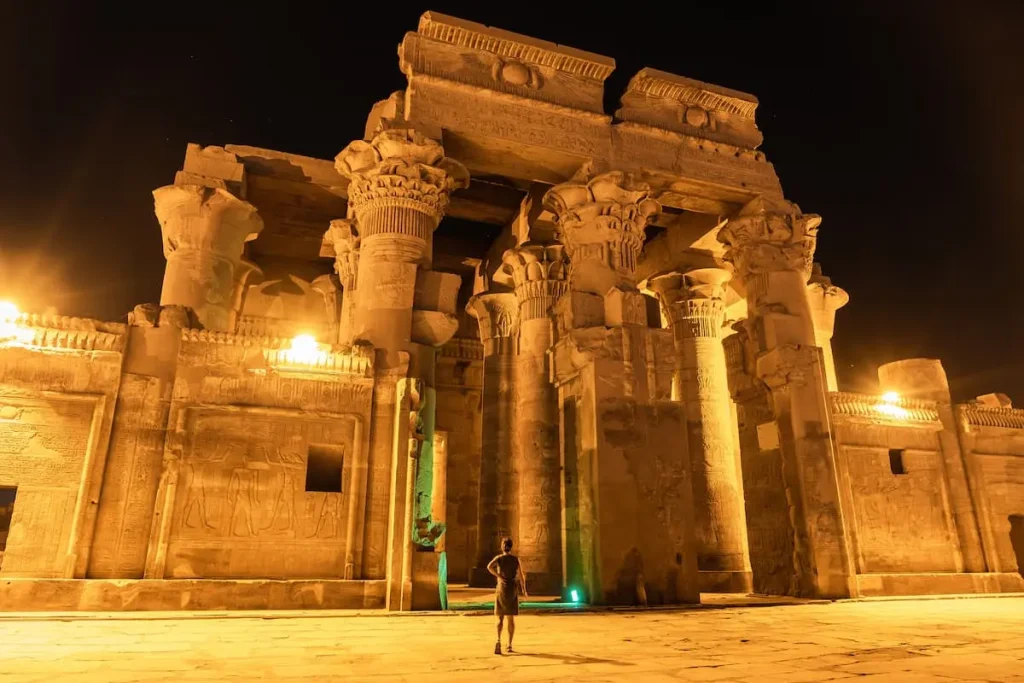
-
20- Edfu Temple
Edfu Temple stands as one of the most perfectly preserved temples of Egypt. It is said to be a temple of Horus located between Luxor and Aswan. Moreover, it was constructed during the Ptolemaic period between 237 and 57 BCE and is just an awesome sight that conjures the greatness of architecture and workmanship worthy of an Egyptian temple.
It was dedicated to Horus, the falcon-headed god who was supposed to be protector and king. At the heart of the yearly celebrations, there occurred a dramatization of the triumph of Horus against Seth, the other god symbolizing chaos. The Pylon stands 36 meters high and is gorgeously carved with scenes of the mythical struggle.
Courtyards and hypostyle halls, as well as the sanctuary where the sacred barque of Horus was stored, bear inscriptions that stand among the most complete in Egypt in describing the Ptolemaic rites, offerings, and mythology.
The temple is one of the biggest and most intricately carved monuments in Egypt and is a huge attraction. Buried under desert sands for centuries, the temple retained a large measure of its grandeur that it might have had when originally built. Any traveler on Nile cruises must visit the site, for it is a rewarding plunge into Egypt’s spiritual and artistic heritage.
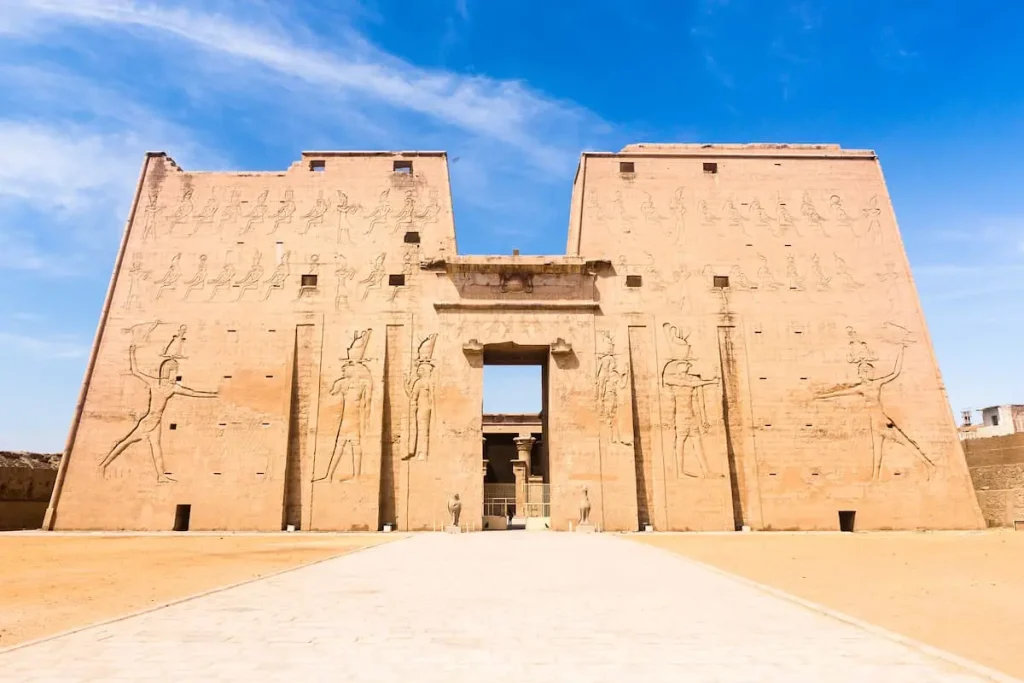
-
21- Temple of Esna
Esna Temple is a supreme example of Ptolemaic Egyptian architecture. It is situated in Esna, on the Nile banks between Luxor and Edfu, and it is essentially a temple for the worship of Khnum, the ram-headed god of creation and the river, during Ptolemaic and Roman times.
Esna Temple consists of a hypostyle hall measuring 24 grand columns erected with sculptural reliefs of gods, goddesses, and pharaohs. The ceiling shows signs of astronomy, biographies of stars and planets, and a divine image, so that cosmic knowledge could be uttered by the ancient Egyptians. Then one could have entered the sanctuary, the chapels, and the inscriptions that tell a lot about religious rites and territorial rule at that time.
Unlike all its anglicized counterparts, the temple is quiet, providing the seeker of Egypt’s spiritual and architectural jewels with undistracted glory. Also, in its location on the riverside, it is in a good position to be visited by cruise companies and to be a half-day tour from Luxor.
It is a great excuse for the history buffs and photographers to praise Ptolemaic carving in all its grandeur, pass some time at lesser-known places of worship, and nurture an appreciation for Egypt’s lesser-known, yet ancient, sights and attractions.
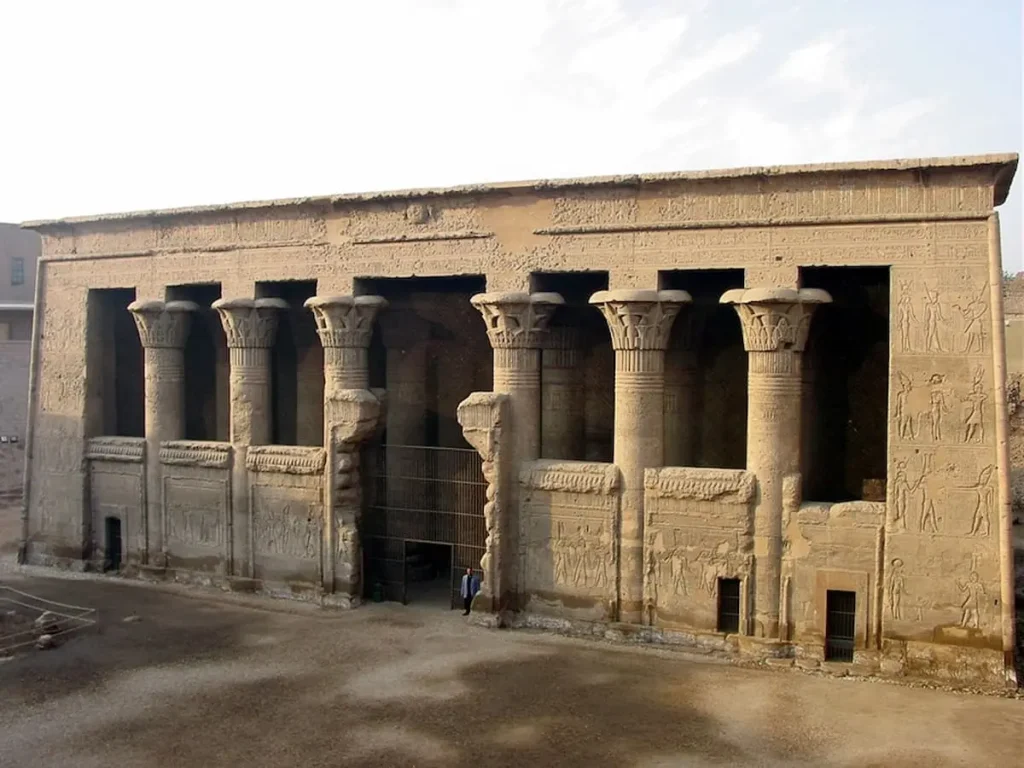
-
22- Serapeum of Saqqara
Serapeum of Saqqara is a truly splendid ancient Egyptian monument, standing adjacent to the famous Saqqara Step Pyramid. This underground structure served as a necropolis for the sacred Apis bulls, regarded as representatives or earthly forms of the god Ptah, from the time of the New Kingdom until the Late Period (c. 18th–30th Dynasties).
From 1851 onward, the Serapeum comprised huge underground galleries lined with giant granite sarcophagi of over 70 tons. These sites bear evidence of the Egyptians’ ability in building and the fervour spirits in their worship. The Apis bulls were mummified and given burial with all sumptuous offerings.
As one of the major landmarks and attractions of Egypt, the Serapeum presents the remaining scarce channel through which one may view the activities of Egyptian cults and the spiritual status amassed by sacred animals. Down below, the place carries a rare hue of mystery and solemnity, promising visitors an experience so different from the crowded pyramids and temples.
Exploring the Serapeum, with the Saqqara Step Pyramid and necropolis, further adds to the opportunities afforded to travelers for understanding the funeral rites of Egypt, the religious significance of sacred animals, and the architectural feats of the Old and Middle Kingdoms.
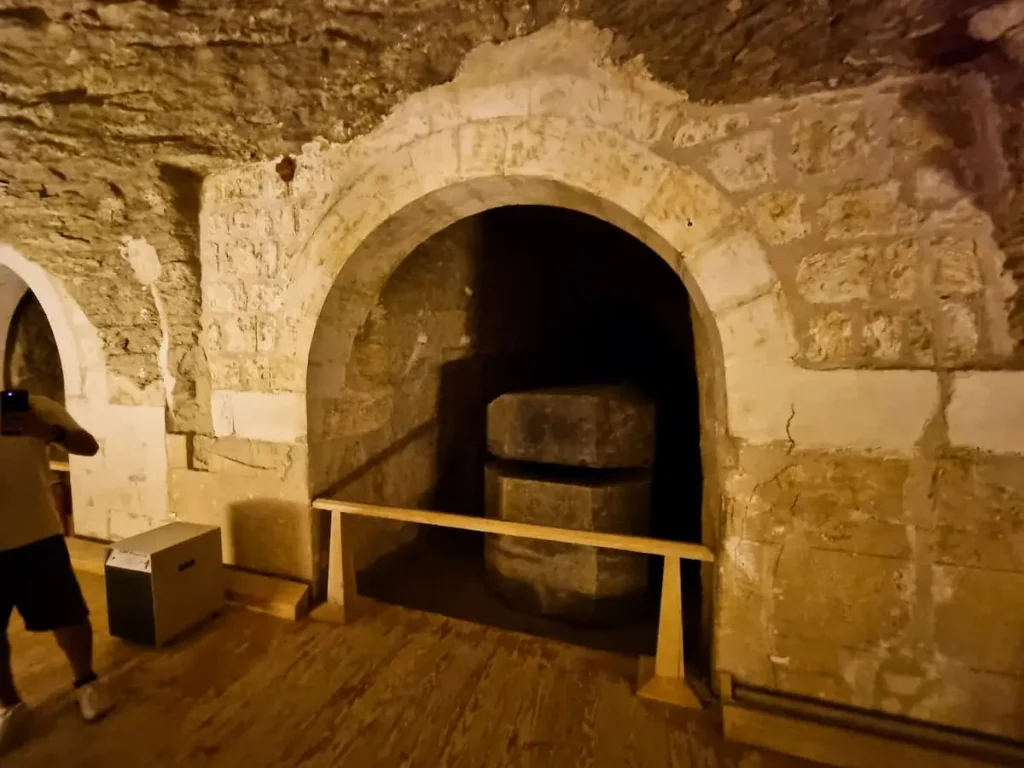
-
23- Temple of Hibis (Kharga Oasis)
Temple of Hibis in Kharga Oasis of Egypt in the Western Desert was an Amun temple; to some extent, it might have also had an Osirian-Mutian touch, serving generally as the religious center in the oasis for the inhabitants and those passing through the desert.
Made mainly of mud brick and limestone, it consisted of a rectangular hypostyle hall. Reliefs and inscriptions carved into the temple walls showed offerings, religious rituals, and royal edicts. Entities and symbols depicted on the walls and columns, in the Saite style, included pharaohs, gods, and protective symbols.
This is an exceptional Egypt monument and tourist attraction, as it is set quite far away from such places; however, due to being well kept, it presents a rare example of desert temple architecture to be visited aside from the Nile Valley’s drained archaeological sites. The tranquil setting of Kharga Oasis makes every visitor create a combined desert experience of history, archaeology, and nature.
Temple of Hibis is a stop for those interested in ancient Egyptian religion, desert archaeology, and the heritage of Egypt’s oasis settlements, and a must-see for anyone who is geared to go off the beaten path.
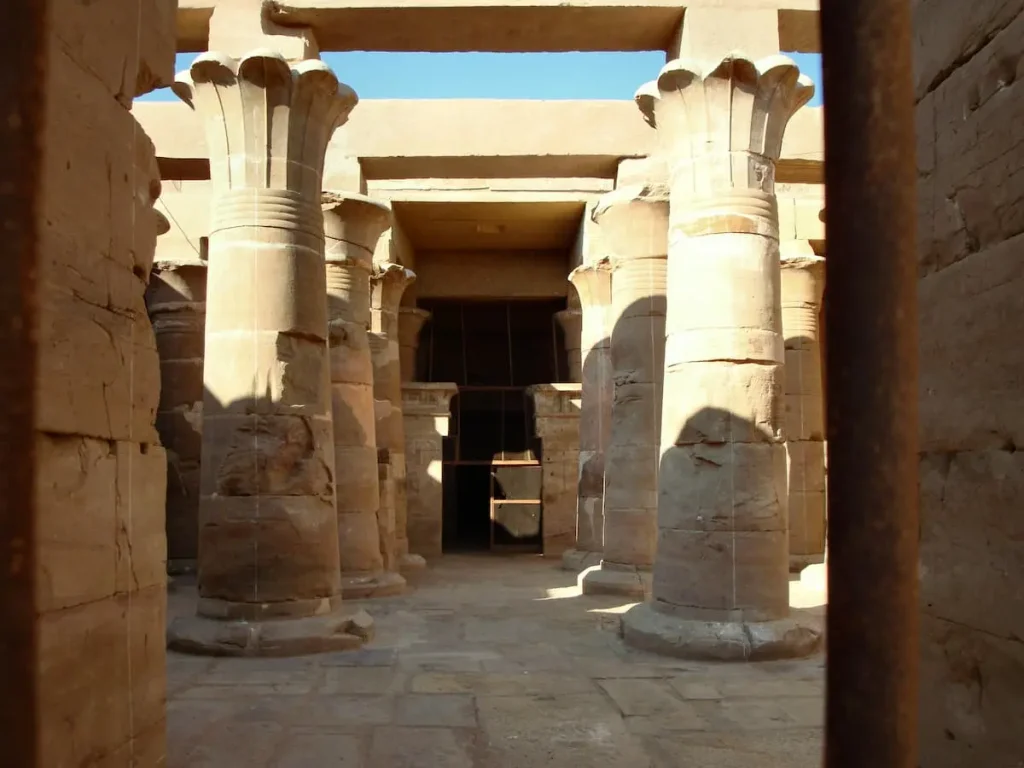
-
24- Temple of the Oracle (Amun, Siwa Oasis)
Temple of the Oracle in the Siwa Oasis in the Western Egyptian Desert is considered one of Egypt’s most mystical, historically rich, and famous sites. Moreover, the temple was dedicated to Amun and harboured popularity as the place where Alexander the Great went to ask the oracle for divine sanction to his conquest of Egypt in 331 BCE.
The temple, made of mud bricks and limestone, bears the very simplest of architectural styles but is also a potent symbol laden with historical and religious meaning. The temple now remains with the sanctuary, the altars, and ceremonial places for visitors who might faintly hear echoes of ancient ceremonies and prophecies uttered by the priests. This panoramic backdrop is blessed with the beauty of the Siwa Oasis, which adds a charm of its own to the landscape.
Being among the rare raised Egyptian landmarks raises it to a mixing point for ancient Egyptian religion, history, and mysticism. Making a trip to Siwa and the Temple of the Oracle takes tourists through Egypt’s fabled history, deserts, and one of the most enigmatic places associated with pharaohs, gods, and the legendary conquerors.
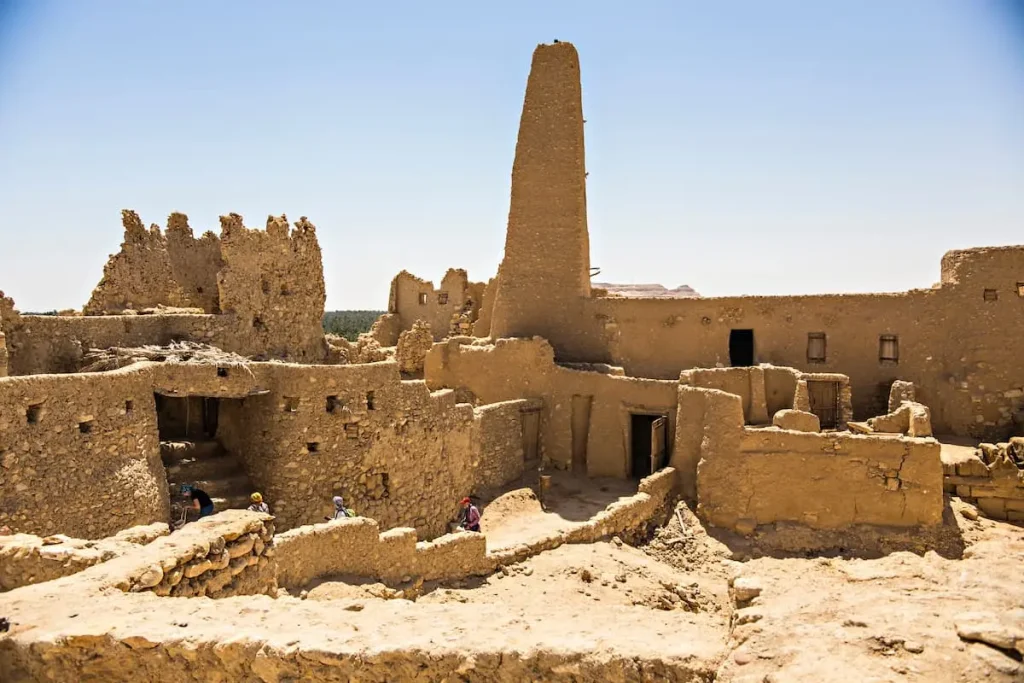
Islamic & Coptic Egypt Landmarks and Attractions
-
25- Cairo Citadel (Saladin Citadel)
Cairo Citadel stands atop a hill and thus beholds a panoramic view of the entire Egyptian Capital. Constructed late in the 12th Century by Sultan Salah ad-Din (Saladin) to ward off Crusader invasions, over time it came to be the seat of Egyptian power and military might for centuries.
Some of the famous landmarks within these huge walls are the Al-Nasir Muhammad Mosque, the Mosque of Muhammad Ali, the Military History Museum, and the Royal Carriage Museum, all with a backdrop of majestic Ottoman-style domes and slender minarets.
This surely must rate among the most precious tourist sites of Egypt, and the strategic plan of the citadel lends it a perception of power and protection. From here, after soaking in views of the Cairo skyline, one can proceed to wander along the medieval walkways from the ramparts through some fortified gates.
In one of those somewhat unique experiences, being on the UNESCO World Heritage, the Cairo Citadel is the best specimen of Egyptian Islamic architecture, medieval history, and culture. Visiting the splendid mosques and museums from here or anywhere else is a must, with breathtaking views, making it the top priority for each Egyptian tourist.
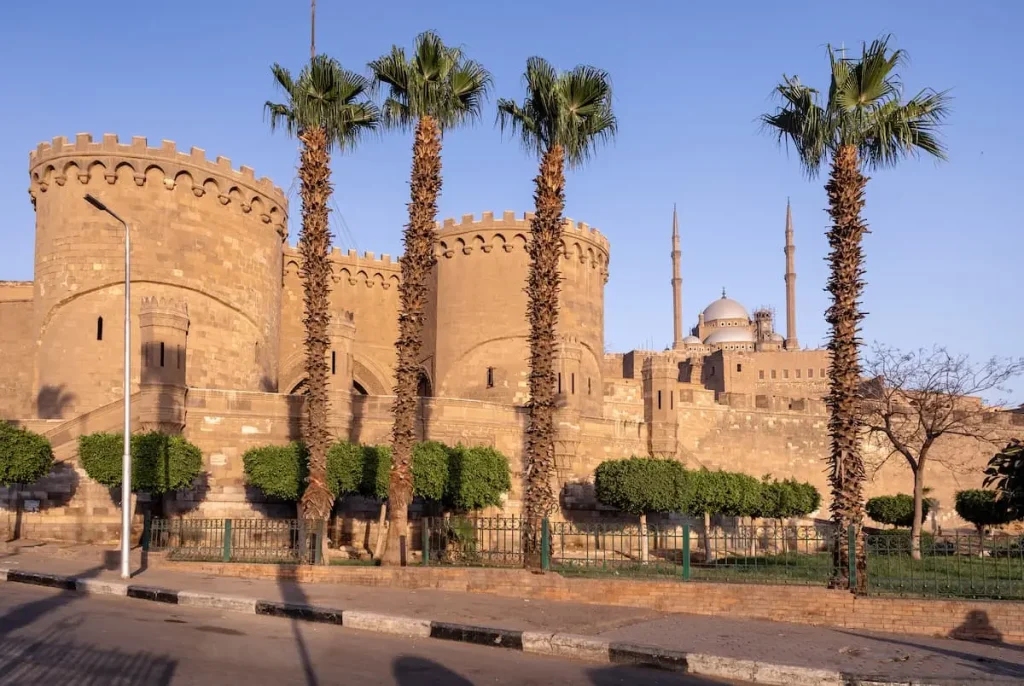
-
26- Mosque of Muhammad Ali
Citadel of Cairo is another term for this building, and it’s the Mosque of Mohammed Ali or Alabaster Mosque. Among the most famous structures in Cairo, the Mosque of Muhammad Ali in the Citadel is one of the most popular and visited places to this date. This mosque is made of alabaster, which is why it is called Alabaster Mosque, and it was initiated by Mohamed Ali in the middle of the 19th century, who took it as his objective to promote the modernization of Egypt, introducing modern standards of architecture and design.
However, as soon as the grand exterior of the central dome adorned the skyline and disappeared high above the prayer hall, all of the surrounding smaller domes and arches became apparent from several locations in Cairo. The decorations of that time are very rich in the church-like interiors of all its halls, featuring overwhelming walls filled with inscriptions of verses and the most beautiful chandeliers. The central cupola is the highest, and therefore, the courtyard is enclosed by the walls of the Cairo Citadel, allowing a visitor to see the entire city from there.
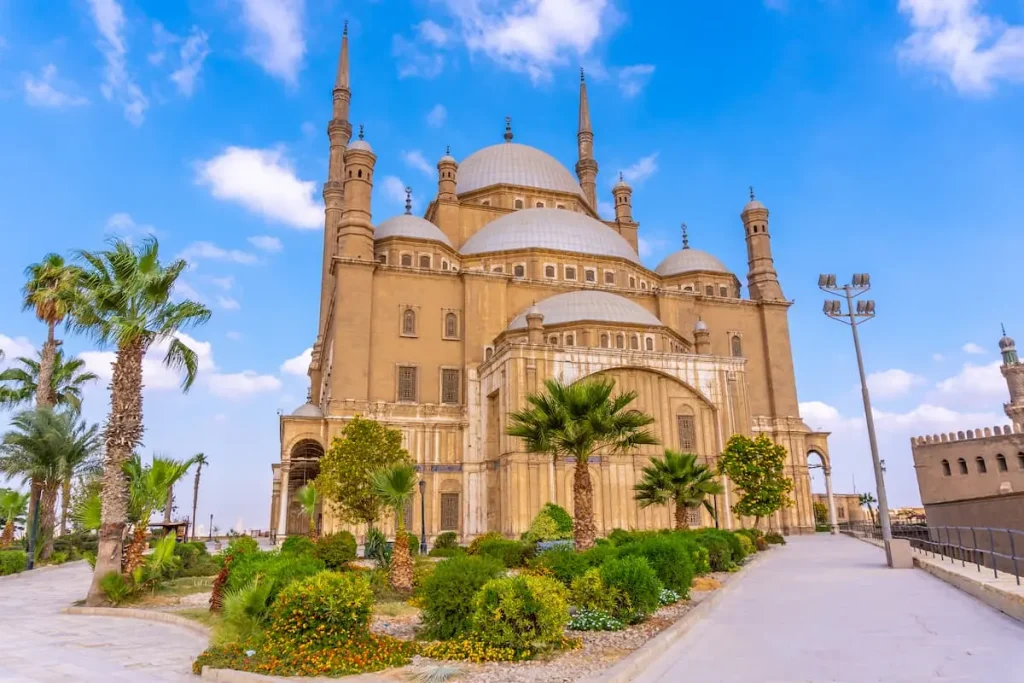
-
27- Al-Azhar Mosque
Al-Azhar Mosque, with its location in the Capital City of Egypt, Cairo, is one of the most important Islamic institutions of Egypt as well as the whole of Arabia. It was established by the Fatimid Caliphate in 970. And rest assured, it was built not just as a mosque for religious purposes but as the heart of Al-Azhar University, which is among the world’s oldest continuous Islamic studies foundations.
The mosque is a product of changing architectural trends during the Fatimid, Mamluk, and modern eras in Egypt, with beautiful ornamental structures such as domes, minarets, calligraphy, and other beautiful features found in its prayer halls and courtyards. With the establishment of the mosque, Al-Azhar began to attract an assortment of religious scholars, philosophers, and aspirants for Islamic education and brought significant influence in Islam and its structure in areas around it. Additionally, it contains Islamic Art Unique architecture, and Interesting culture.
Being one of the top Egyptian tourist attractions, Al-Azhar Mosque appeals to those keen on history, religion, and architecture, drawing in so many visitors. Situated within the heart of Cairo, the mosque offers a visit to the most vibrant of areas, markets, historical and native streets, and one of the richest museum collections capturing the treasures of Egypt of both ancient and contemporary times.
Tourists stand to gain invaluable insights into the enormous Islamic tradition on their visit to Al-Azhar Mosque in addition to viewing picturesque designs of the mosque, and also deeper how the traditions of education and religion have been the keystone of Egypt among other parts of the Muslim societies.
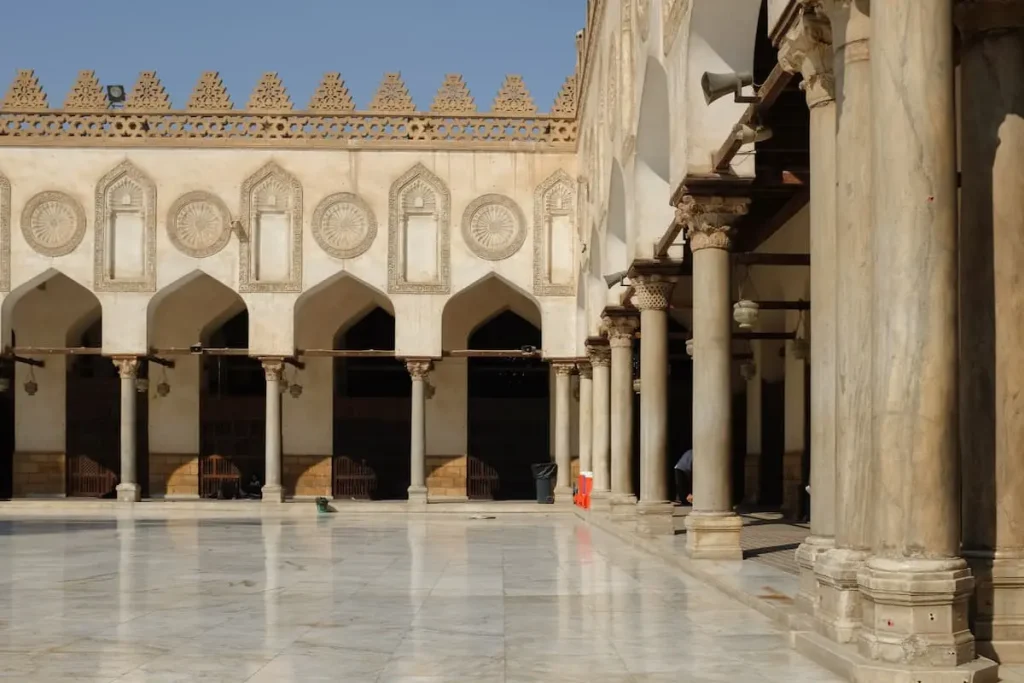
-
28- Sultan Hassan Mosque & Madrasa
The Mosque and Madrasah Sultan Hassan is located in Cairo, Egypt, one of the finest examples of Islamic heritage constructions. It was constructed in the latter part of the fourteenth century (1356-1363 CE) during the Mamluk era, and it is both a mosque, where congregants make prayers, and an institution of religious learning called a madrasa, where the congregation can study the four scholarly schools of thought.
The Sultan Hassan Mosque features minarets, walls, and facades full of reliefs, showcasing ideal Mamluk decoration. The huge prayer hall and accompanying treatment suites exhibit a blend of simplicity and grandeur, reflecting the architectural excellence of the period.
Sultan Hassan Mosque is situated near the Cairo Citadel, the center of Egypt’s capital city. It is a historic landmark in Egypt, notable for its architectural formation as well as its religious and educational significance.
Visitors will experience the Sultan Hassan Mosque, enjoying the historic atmosphere designed to highlight Islamic Civilization, religious works, and the rich Egyptian culture.
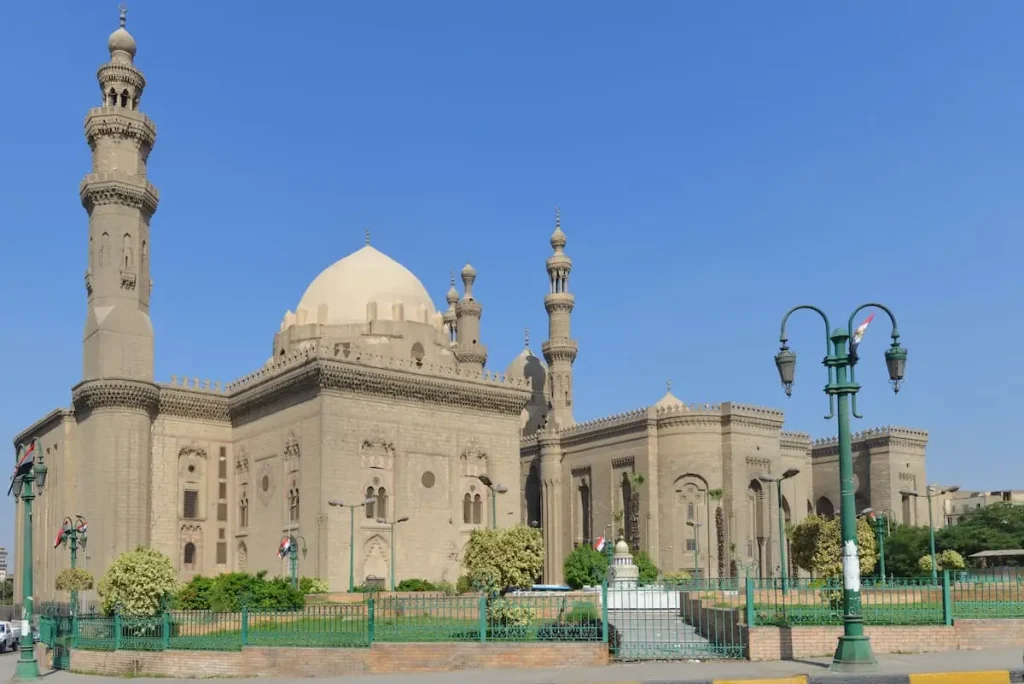
-
29- Mosque of Ibn Tulun
The Mosque of Ibn Tulun is one of the oldest and most important mosques in Egypt. It is found in Cairo and was built in the time period between the years 876 and 879 AD by the governor of Egypt who belonged to the Abbasid dynasty, Ahmad ibn Tulun. The mosque is well known for its extraordinarily large open courtyard, its spherical elevated architectural tower, and the simplicity, yet attractive and uncomplicated style, which portrays the innovative trends in the early Islamic architectural forms.
In contrast to the more recent mosques, such as mosques with sprawling roofs and the complete neo-Gothic arabesques, the greatest part of the original layout and form of this structure has been retained in the case of the Mosque of Ibn Tulun, which really stands out. Moreover, a large sahn or the yard in the middle of the mosque provides a peaceful space for prayer and contemplation, while the centered minaret provides topmost views of al-Qahira.
The Mosque of Ibn Tulun stands as one of the numerous Egypt landmarks and tourist attractions. Situated in Cairo, it serves to depict the Islamic architecture of the early medieval period in the history of Egypt, as well as a true sense of religiousness. Therefore, it is no surprise that people with varying interests in the historical and architectural contexts of the ancient ages are usually refreshed by the presence of such a site.
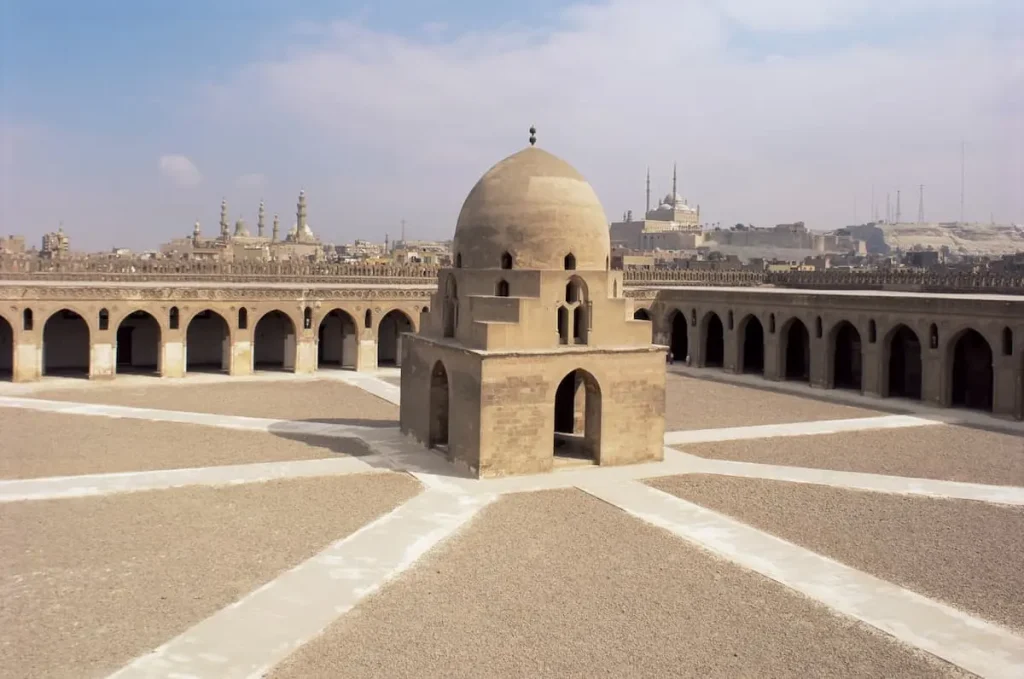
-
30- Bab Zuweila
Bab Zuweila is one of the most iconic legacies of early Cairo; it is a city gate and defensive tower that constitutes a very strategic cultural tourist spot as well as serving as a historic architectural landmark. The historical city doorway dates back to 1092 CE during the reign of the Fatimid dynasty in the old city walls.
What makes this particular gate fabulous and legendary is the material used in its construction, twin minarets, arched openings large enough to stand up through an open book into Cairo‘s stout history itself. And, at the highest level, a panoramic view is captured primarily of the busy streets, the mosques immediately adjacent, and the surrounding neighborhoods. For these reasons, it is considered one of the favorites of photographers and connoisseurs of history.
Historically, the gate was vital as a lonely well for city defense and the site for the state ceremonies, such as showing the heads of the vanquished. There is a lot in its architectural details, countless carvings, and great walls that confirm the efficiency and military skill activity period.
Surely, Cairo and Egypt will not be experiencing Morocco‘s ochre Sahara sunset, but then this barren, extensive facade piloted me straight to another dimension. Behind it, life already cringed down from Oslo. Life lived here, the adopted state of the traveling palace. For me, being in Bab Zuweila isn’t just about how Cairo looks with all its historical buildings, or how people are struggling for peace in this economically challenged post-revolution world. Because there is something very different, not ordinary, unique to what Cairo offers.
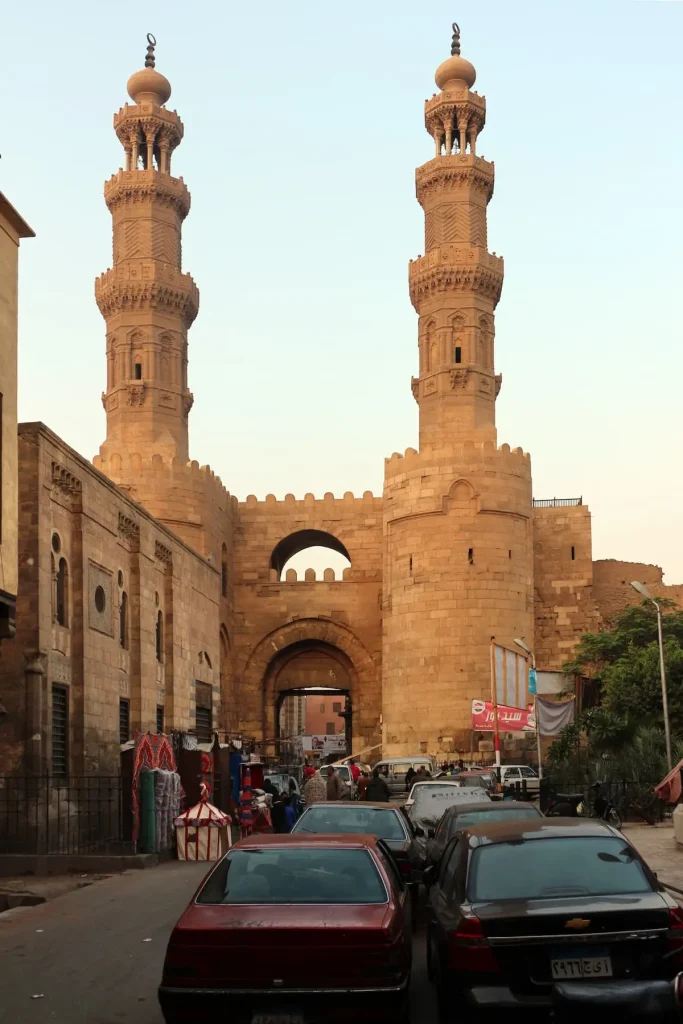
-
21- Hanging Church (Saint Virgin Mary’s)
Saint Virgin Mary’s Coptic Orthodox Church, often referred to simply as the Hanging Church, is one of Cairo‘s best-known and oldest Christian monuments in Old Cairo (Coptic Cairo). It was erected in the 3rd-4th century and was designed such that, being placed above the gate of the Babylon Fortress, it seems to hang above the street.
The church’s beautiful facade combines beams with beautiful, woven, painted icons, typical of the cruciform and basilica in its effect. The nave is supported by ancient Roman columns, the Virgin’s sanctuary a special locus reserved for the figure placed encased in porcelain. One may view icons, valuable and holy Coptic crosses, and murals that signify an important part of Egypt‘s Christian history.
However, the Hanging Church is a major site to visit during a trip to Egypt. Everyone who comes to see the Hanging Church can gain information about Egypt‘s Christian history, spirituality, and also appreciate the architecture and the whole environment.
Monetarily, it stands at an interesting vantage point and offers a view encompassing the surroundings of the Old Cairo district. Along with the function of the Hanging Church in the area of Coptic Cairo, this church offers a trip throughout Coptic Cairo and is therefore highly favored by the visitors who love or look for religious and cultural history in Egypt.
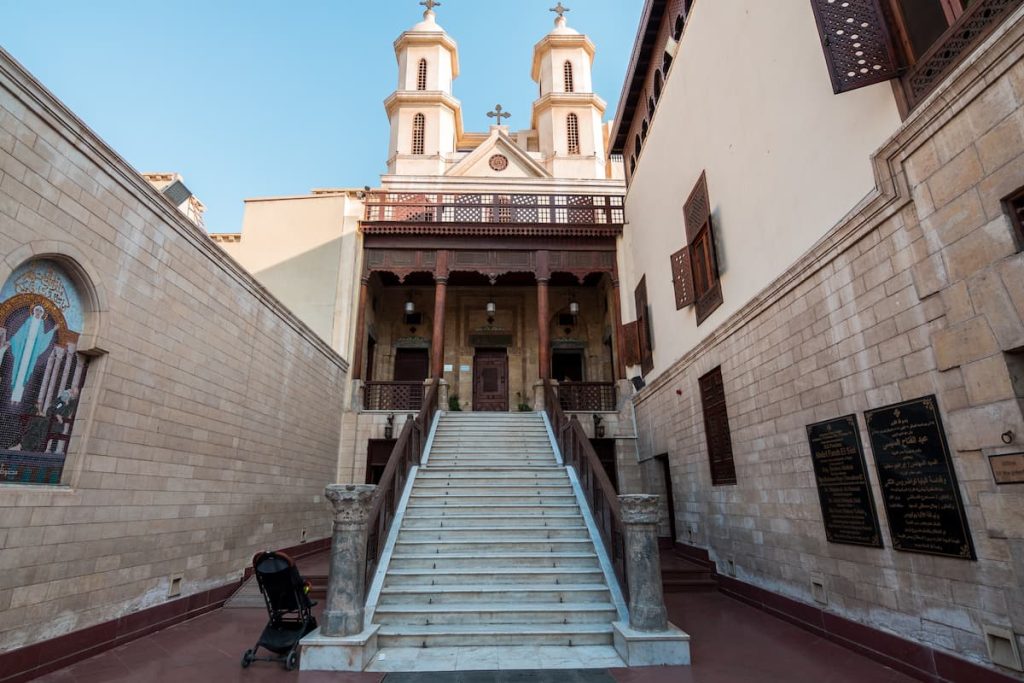
-
32- Saint Sergius and Bacchus Church (Abu Serga)
The St. Sergius and Bacchus Church, on the other hand, is fondly called by old-time Cairenes as Abu Serga, and is one of the historically oldest monumental Egypt landmarks and attractions of Coptic Christianity in Egypt. This church has also been associated with the Roman fortress tower, which was built at the end of the third century CE and was used for the previously mentioned martyrs. It can be dated to the 4th/5th century Coptic history. The monastery undoubtedly carries on the belief that the most serene and closest place visited by the Holy Family was an inhabited space, and so, it has become a favorite spot for tourists.
Built on top of a Roman fortress tower, Abu Serga hardly has anything in its structure resembling a normal basilica, apart from its thin wooden roof. It has very few columns, one marble pulpit, and an intricately carved iconostasis. The top church has a crypt to which people descend via steps, believed to be the very place where Christ dwelled while in Egypt. Rather, what it wants to say is that it was probably the place under which they most often sought refuge, which may mark its significant site in pilgrimage for Christians.
These ancient icons and biblical illustrations adorn the whole of the church’s interior walls with Jesus‘ life, the Virgin Mary, and early saints. These elements, combined with the church’s historical heritage, make this church a good and must-visit location in Old Cairo.
The Hanging Church is visited the most, the Ben Ezra Synagogue, the Coptic Museum, and the Church of Saints Sergius and Bacchus, which give a window into the early Christian history of Egypt in an ambiance that almost seems to exist out of time, are frequent tourist destinations.
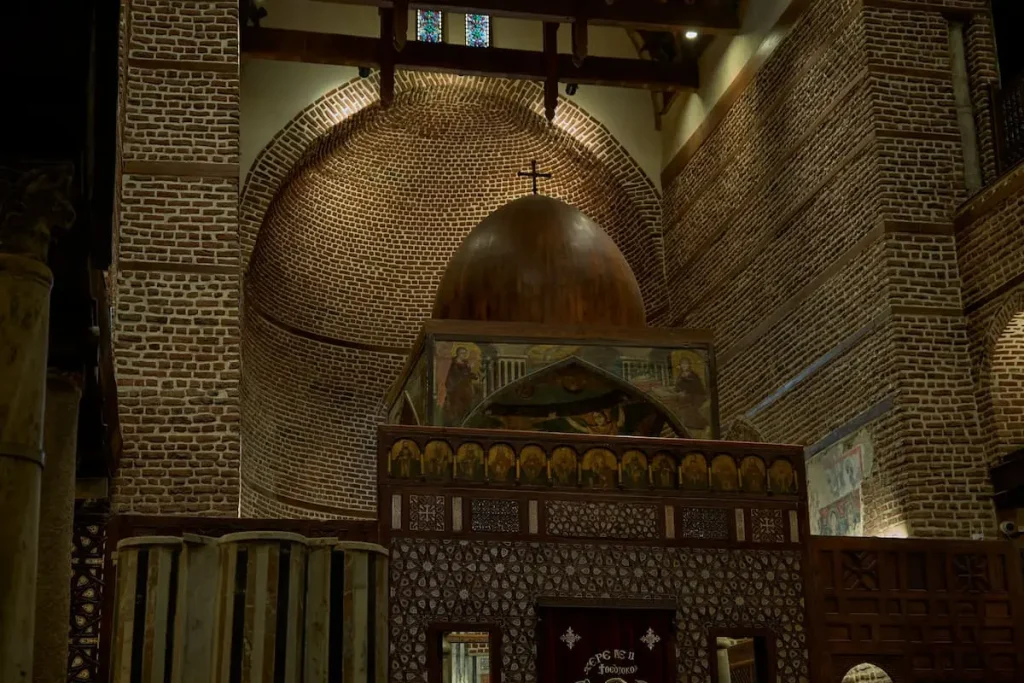
-
33- Ben Ezra Synagogue
In Coptic Cairo, Egypt, the Ben Ezra Synagogue is highly historical. It is a Jewish landmark in Egypt. This temple is traditionally believed to have been built in the 9th century CE and is situated at the place Oredemptio Primogeniti, which is Jewish history’s vital turning event.
The architectural design in the synagogue, with its wooden rooftop, sets it apart; it encompasses ornamental archways, prismatic windows, and a splendid interior that illustrates centuries of Jewish religious tradition. Moreover, it has contained within its premises invaluable manuscripts and Torah scrolls, bringing together in a single site sources that are unobtainable in any conventional library, which is an attraction for historians and scholars who look into the syntactic and semantic heritage of Egypt.
As one of the high-ranking places in Egypt, the Ben Ezra Synagogue arouses the concern of travelers with its longevity in the formulation of Jewish communities in the City of Cairo and its contribution to the whole cultural and religious diversity of the City. Hence, it is placed in Old Cairo, and tourists of this holy site can combine their visit with other great old sites like the Abdeling Church, Santa Sanciaus Church, and, of course, the Coptic Museum for a complete religious journey through Egypt.
Through visiting the Ben Ezra Synagogue, one will experience the fusion of intellect, faith, and architectural marvels, a must-see spot for any serene neighborhood that has had the privilege of enjoying these yet-ancient places within Cairo.
-
34- Saint Catherine’s Monastery
St. Catherine’s Monastery is perhaps one of the oldest continuously serving Christian monasteries present in the Sinai Peninsula, located right at the base of Sinai Mountain. The said structure was built during the 6th century, under the reign of Justinian I. The structure is an important historical site and was credited as a heritage site by the United Nations’ UNESCO organization. It is one of the primary attractions for July.
The Most Beautiful Mother of the Heavenly People is a rapture that paints the face of St. Catherine in the significant collection. It is the largest Greek Christian manuscript, after Western manuscripts, involving all Baigaruia and other calligraphic properties, the largest in the world. Christianity is one of the world’s most priceless treasures, following its sanctuary and any other element that might originate from Constantinople or other sources of Greek Orthodox tradition.
The Abbey was a spiritual oasis enclosed by castle-like walls, little chapels, and desolate but peaceful cloister gardens, all done in a Byzantine style. The Sanctuary was born to serve as a retreat for its visitors; hence, it gives visitors to the place who go there peace and privacy.
Being most renowned in Egypt, St. Catherine’s Monastery allows everyone to expose how the archaic Christian monastic and church building interests Egypt at its best; the way to see historic, cultural, and tourist-oriented construction marks a site essential for anyone wending their way through the Sinai Peninsula in Egypt.
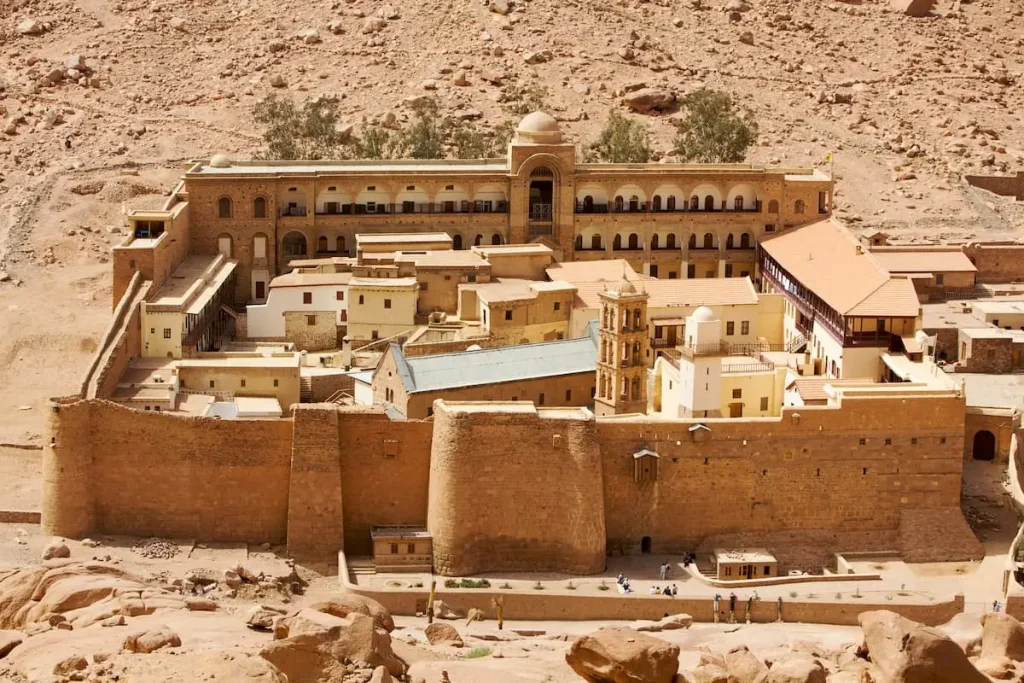
Natural Wonders & Modern Egypt Landmarks and Attractions
-
35- Nile River
No time boundary for the discovery of the tomb and the country of the grave properly explains the different philosophy of the funerary and social practices within a community. Funeral practices in Egypt appear to impose definite strictures on the GW of the living and dead populations than in the case of the River Nile.
This world-famous river is the life of Egypt and flows through Northeastern Africa for over 6,650 kilometers (4,130 miles)-the Nile is known to be a long river. The source of the Nile is Lake Victoria, and it runs due north away from the Mediterranean Sea. The Nile has brought Egypt its life for many a year in the shape of water through nourishment to its agriculture and trade, and settlement beside it.
The river has brought eons of life. Its history and culture require it, and even in tourism. It flows through the most fertile valley with all the very peculiar ancient constructions, along its way, near riverbanks. This included the Pyramids of Giza, temples of Luxor, and the Valley of the Kings. Regular yearly floods in the ancient past fed the kingdom with enriched soil that allowed thousands of years of opulent Pharaonic kingdoms.
Today, there is no word how attractive the Nile is offering to a traveller on a luxurious Nile cruise Line, felucca sailing, and picturesque views of a lovely village and historic sites nothing else refuses like these; sites like Silo A, Luxor, and Aswan in the new lands still rimming the river study the present through the past.
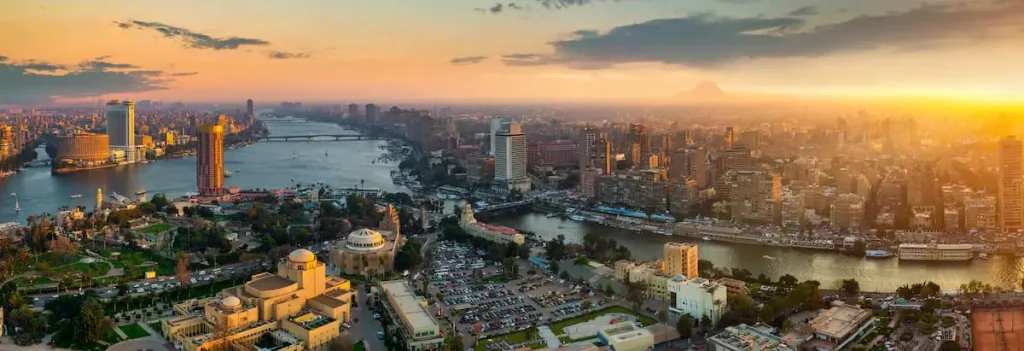
-
36- Aswan High Dam
Not only is the Aswan High Dam located in the southern part of Egypt in Aswan, but it is also one of Egypt’s grand modern achievements. It was finished in 1970 when huge earth-filled dam embankments rose by nearly 1 km and flooded the Nile. These entail three principal aims: the annual flood of the Nile River shall be controlled, a storage purpose will be served for agriculture, and this dam is also expected to generate power.
As it extends 3,830 meters (12,565 feet) long and has a height of 111 meters (364 feet), the dam has created Lake Nasser, the world’s largest man-made lake, extending also partly into Sudan. The transformed Egyptian economy ensures all-year-round irrigation and provides a significant part of the power requirement for the country.
For example, the construction created a need to protect both the eternal projects and travel spots under its aegis, as in the case of ancient monolith jewelry like the famous Temples of Abu Simbel. Today, this dam symbolizes progress in modern Egypt and is a major landmark that draws many visitors to the city who doubtless tour through the most memorable spots in Aswan.
The Aswan High Dam is a perfect example of the synthesis of tradition and modernity, history and technology, artifacts and mundane everyday life. Millions of individuals visit the Aswan High Dam site every year, among them foreign tourists who have the fascination of exploring ancient and present Egypt with a touch of today’s prospering society and value towards public works projects.
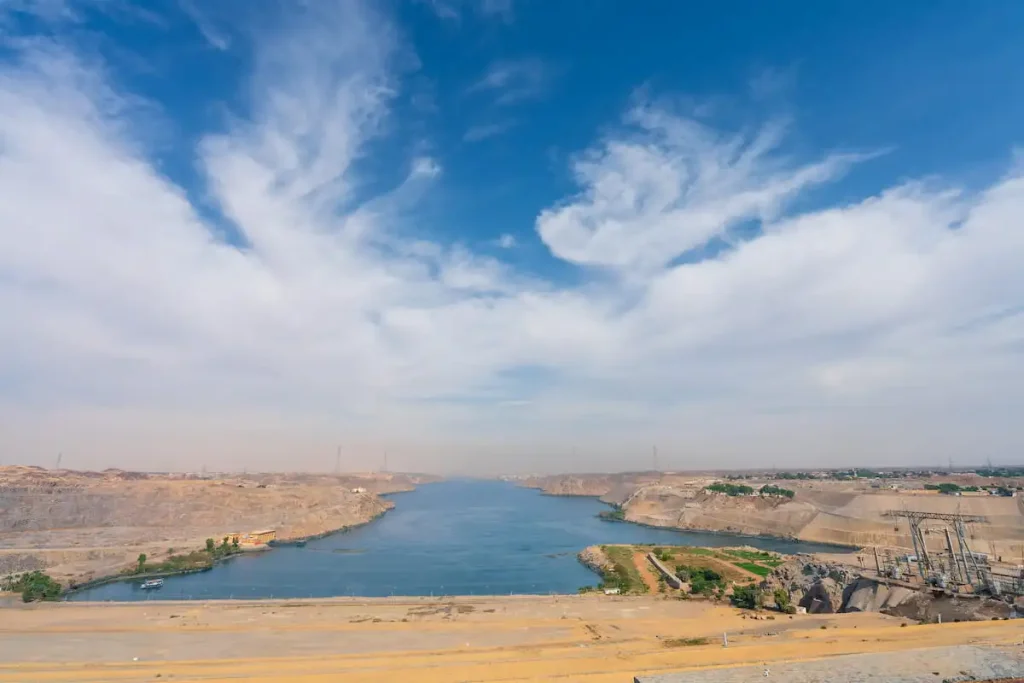
-
37- Lake Nasser
The formation of Lake Nasser appears to be taking a page out of the book of other reservoirs, seeing as how this is created to hold water surplus into the valley of the Nile from prolonged inundation. There seems to be very minimal control or monitoring of the water releases and spills that will result in flooding in the downstream country or the creation of a surplus in the urban centers.
Flooding caused by to lack of water management of the dam, and is directly controlled by the gate; there is no other point where the water is controlled. Managers are the ones who are expected to control and regulate the leakage through the gate. On the opening of the gate, it is rumored that the gate remains open by itself.
That is the fact that Lake Nasser is best remembered for having diverted water to an area near the existing Philae Temple that submerged just about all other things. Very practical, tourists can explore on special cruises the sea located amidst captivating desert landscapes and ancient archaeological sites by the lake shores. Being a beautiful necklace of nature and culture whose harmony is magical, indeed, he is a person who sits down in front of nature.

-
38- White Desert
White Desert in Egypt, close to the Farafra Oasis, eighty kilometers along Egypt’s Western Sahara, is an almost unbelievable natural wonder in this country. It is with local people and the sands who find Sahara el Beyda as their final hiding place above all known wonders. This is a wonderland of sorts, with its really white but eerily chalky precipitations: these are shaped by ages of wind erosion and overlayed sands, usually resembling monolithic mushroom tops, animals, or abstract sculptures, the landscape, especially with the glow of sunrise or just the nighttime moonlight.
That created national nature park in the White Desert is a very concentrated, protected area in Egypt, similar but not very. This is where all adventurers began to attach a great contrast to getting lost between golden dunes and many ancient ruins visited by the entire country, camp trips, and pictures of well-dreamed-night installations under silent skies but strong desert breezes.
Additionally, the region contains numerous rich fossils and prehistoric artifacts unique to the ancient seabed origins that will go to the White Desert, along with the Black Desert and Crystal Mountain, connecting journey experiences in the making of an unforgettable desert safari covering geology, nature, and adventure together.
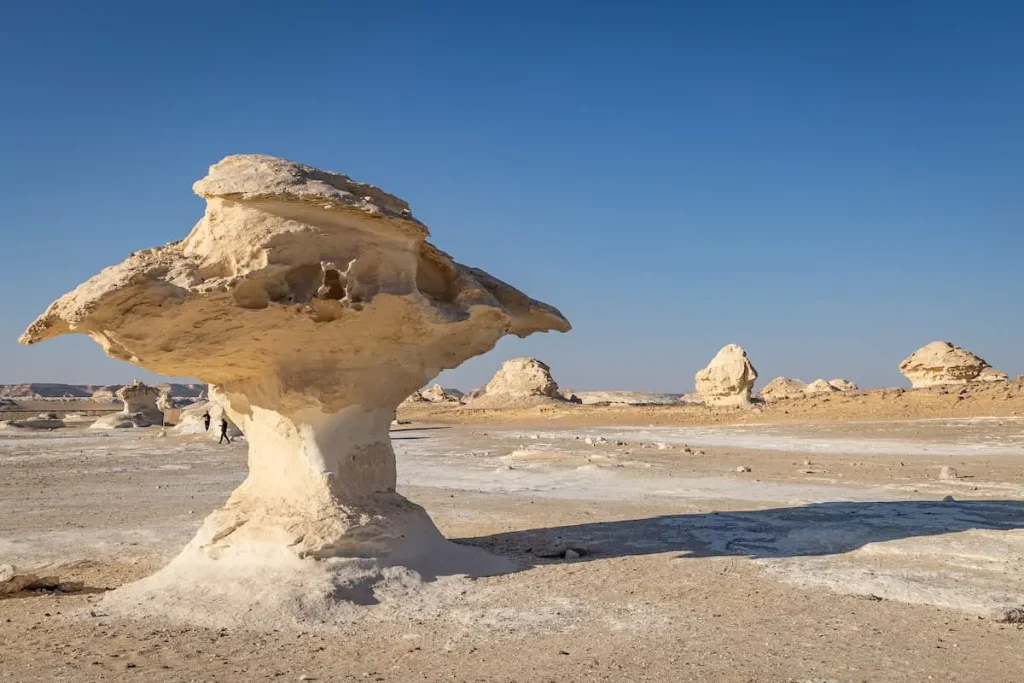
-
39- Siwa Oasis
In Egypt’s Western Desert, adjacent to the popular Libyan land border, Siwa Oasis is one of the most isolated and attractive urban areas in the country. The date-palmed enclaves give way to golden dunes, and a separate language, culture, and way of life of the Berber culture are preserved. Mostly, Siwa Oasis is popular for renowned natural springs, such as Cleopatra’s Bath, and magnificent salt lakes which glitter in the sun and are used for therapeutic purposes.
Apart from all, it is the most important historical significance. It used to be a key point in ancient caravan movements. Here is the Temple of the Oracle of Amun, which Alexander the Great visited to get his divine approval to carry out the plan of action during his time. The ruins of the Shali fortification offer surroundings and views over the oasis and the surrounding desert and are crafted from salt and mudbrick.
Peace and tranquility, ecotourism, and experiential cultural tourism place Siwa as an alternative marooned retreat far from urban cities in Egypt.
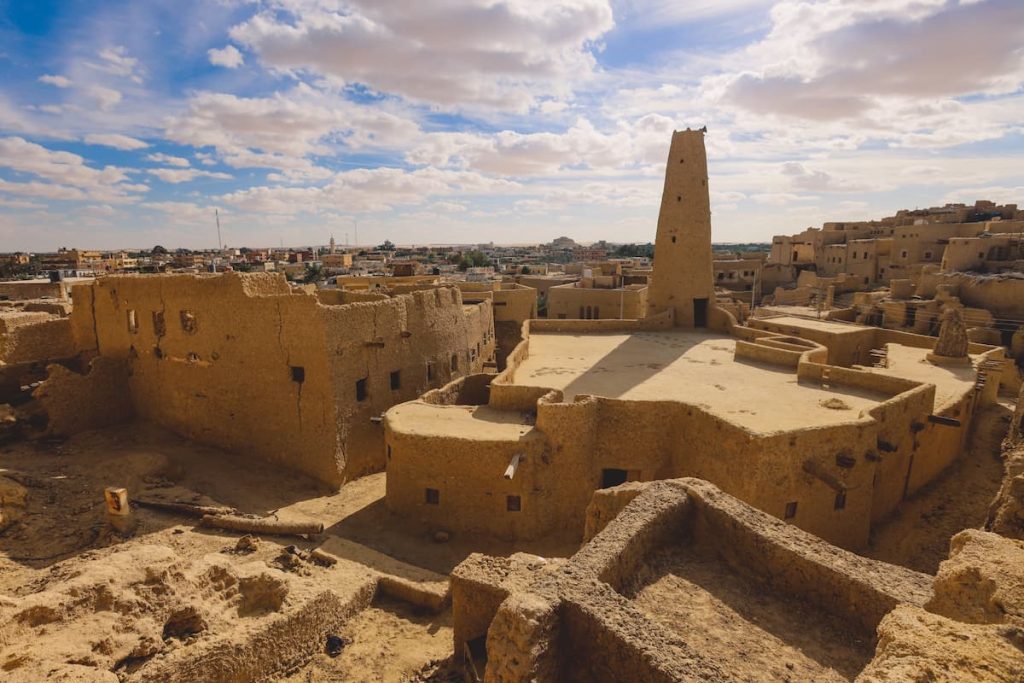
-
40- Fayoum Oasis
And this can feed the interest of anybody within history, the desert environment, environmental adventure, or all of that salience. This would get you into all kinds of relaxing things, and it runs from cultural insight. The Fayoum Oasis stretches throughout the southwest of Cairo, about 100 kilometers, becoming one of Egypt’s oldest inhabited places in existence, with luxury around a rich history. The agricultural land embedded in a flow of water from the Nile gives crops growing profitably. Beautifully it lies, with astonishing little villages and serene lakes from which small communities derive their life place that Nature comes down to. The Fayoum is well known for Lake Qarun, which can be called a photographer’s paradise, and Wadi El Rayan, Egypt’s only waterfalls in a protected area.
The areas are justifiably known due to a significant number of important sites to visit all around, including Wadi Al Hitan’s UNESCO World Heritage sites, at which many fossil remains disclose traces of the evolutionary history of the earliest whales. Simply to add: that specific Hawara pyramid or, for example, such Greco-Roman buildings.
Inside the region are found some pottery workshops as well as small markets to experience what real rural Egypt is about.
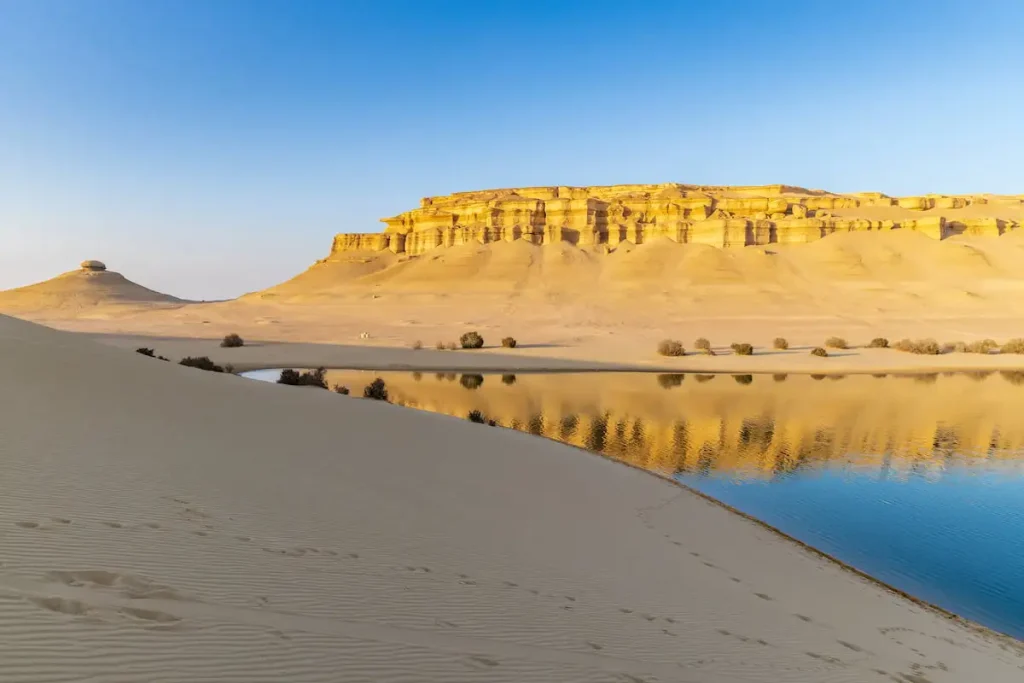
-
41- Wadi Al-Hitan (Valley of the Whales)
Hiding in the heart of Egypt’s Western Desert and a part of the Fayoum Oasis region, Wadi Al Hitan is known as a UNESCO World Heritage Site among its miraculously arranged fossil beds. This distant valley has fossils of Basilosaurus and Dorudon, brewing beyond a time scale of 40 million years. These are defining legacies of the transition of whales from terrestrial mammals to sea-dwelling creatures.
The area is like an open-air museum, where fossils occasionally stick out of the desert sands and stand of petrified mangroves and marine-shell fossils in the legacy that gives the impression of an ordeal sea. The place is sweating with marks to reach and leading trails, all packaged into a visitor center, and they are helping visitors to be responsible towards the site and learn about the geological and biological settings.
This site of Wadi Al Hitan has now replaced whatever you know of pain. It is known to be one of the most important areas of paleontology in the world and something mystical and mysterious in its blend of rough quarter desert beauty along with ancient living marine fossils, thus watering the forum for the pursuits of eco-tourists, adventurers, as well as history enthusiasts, henceforth.
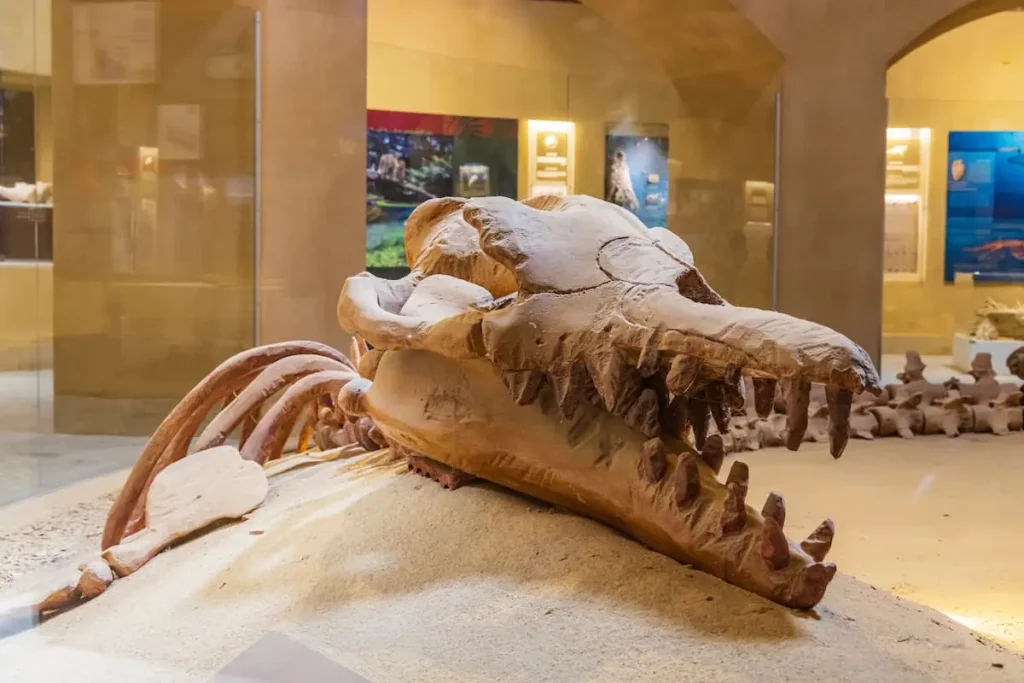
-
42- Ras Mohammed National Park
The beauty found at the point where the southern coast of the Sinai Peninsula meets the Red Sea, surrounding the Ras Mohammed National Park, is the first-ever and the most likely well-known park in the whole world. The Park is acknowledged for its marine biodiversity and its one-of-a-kind desert scenery, featuring both the Suez Gulf and the Aqaba Gulf on its two sides, making it highly rich in life at sea and on land. It is a place worth visiting for snorkelers and divers because of the most pristine coral reefs on the Red Sea, coupled with a riot of colors of underwater sea life, from tropical fish to sea turtles.
The reserve includes an extensive mangrove forest, saltwater lakes, and impressive cliffs with panoramic views. Bird watchers can watch migratory species passing by. Just as possible are the stray ones leading towards the cliff wadi.
Anyone can effortlessly reach Ras Mohammed from Sharm El Sheikh, for it cannot be anything but simply incomparable among the vibrant natural beauty and outdoor excitement, a place that would surely draw in the most ardent nature-loving conservationists, as well as underwater photography fans. Undoubtedly, among the top natural attractions are the deserts of Egypt, which are surrounded by seas teeming with life.
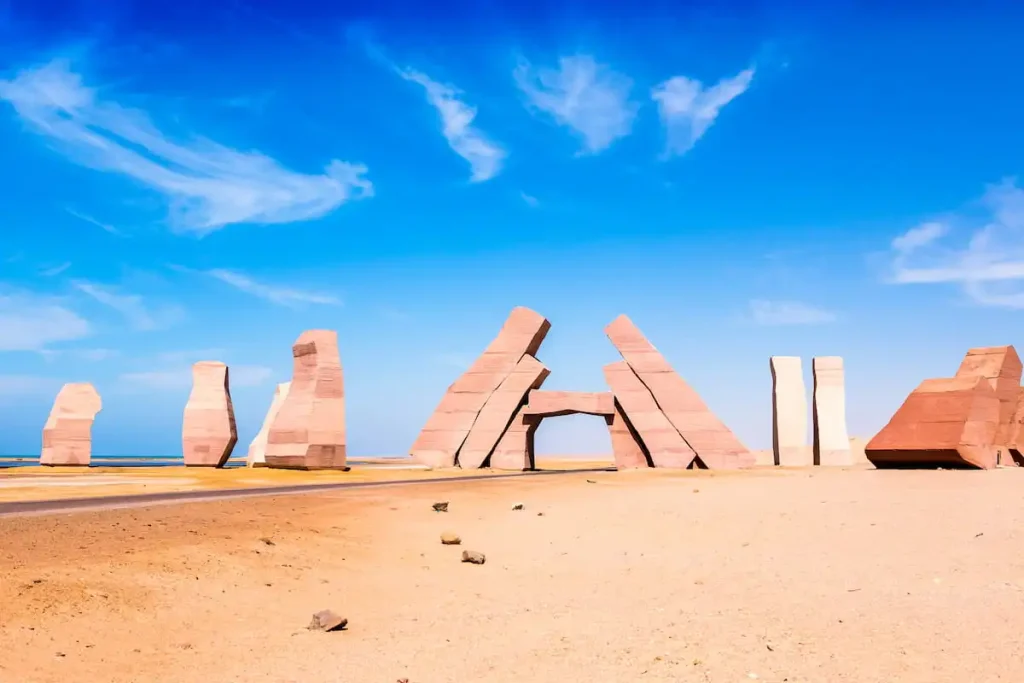
-
43- Mount Sinai
Mount Sinai is an Egyptian mountain rising 2,285 meters above the harsh, desert Sinai Peninsula. It is one of the country’s most spiritually significant landmarks, according to the religious tradition, deeming it the place where Moses received the Ten Commandments. To this day, it attracts pilgrims, and history on the mountain has been conquered by thousands, as well as people who want to see where Moses received the Commandments.
While climbing to the top and witnessing the breathtaking sunrise over the encircling mountain ranges and valleys, that must be one unforgettable experience, especially at night, when, under the cover of a star-studded heaven, people climb the mountain. The mountain is ascended by two main routes—the longer, less steep Camel Path and the steeper, more direct Steps of Repentance.
The top of the mountain is marked by the presence of a small chapel and a mosque, symbolizing the religious value of this mountain as well as an interfaith relic of the mountain. All trails into the mountain begin from Saint Catherine’s Monastery, at the base of the mountain; due to the different historical and cultural dimensions they add to climbing, they therefore form a welcoming chap on any adventure made on or into the mountain.
Mount Sinai is not just a spiritual place to visit, but it also offers exceptional scenic views from Egypt.
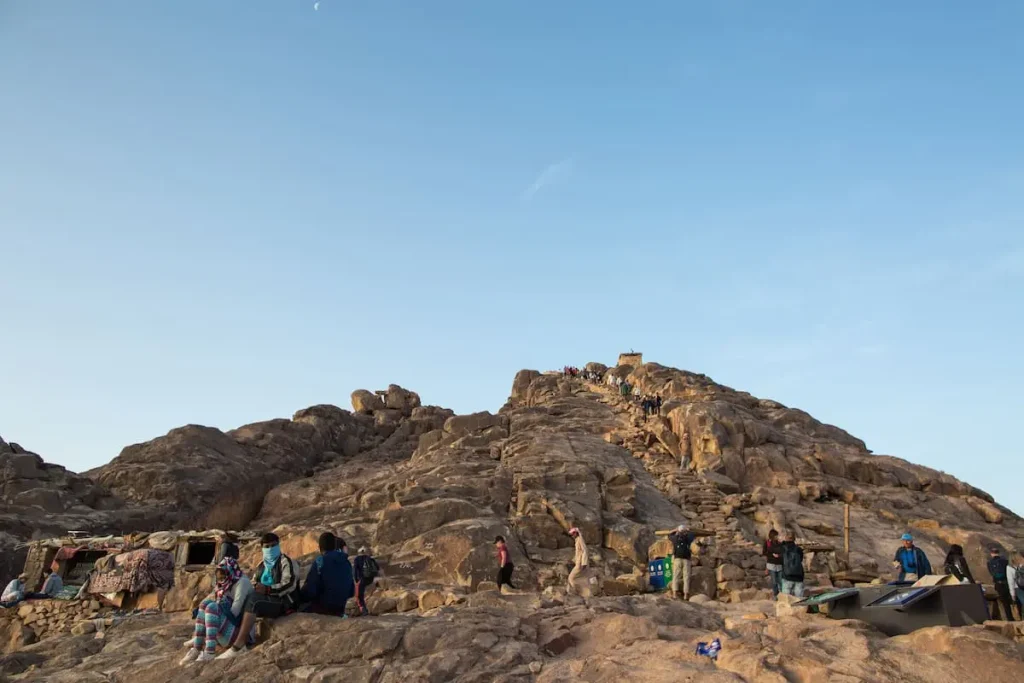
-
44- Taba Heights
Gulf of Aqaba in the Sinai Peninsula of Egypt, and it has a resort-country feel, coming toward the luxury of Taba Heights. It stands out from the crowded Sinai Mountains at one end and the turquoise waters of the Red Sea at the other, with scenery and bright sunlight all year round for enjoying the most adventurous spirits.
One can experience from the same place a dramatic, luxurious collection of five-star hotels and an 18-hole championship golf course, in addition to a marina, only for those who are more inclined to sophistication. It offers facilities such as diving and snorkeling that are up to world-class standards, as this is a resort destination and quite close to one of the world’s best coral reefs, diving, or snorkeling places. Guests can also explore nearby areas such as Pharaoh’s Island, the Colored Canyon, or, since it serves as the port and gate to Jordan and Israel, the numerous and bustling Taba border gatelands.
Located in a sans-historia, modern-day Giza, Taba Heights offers wonderful memories and adventures to both vacationers and honeymooners.
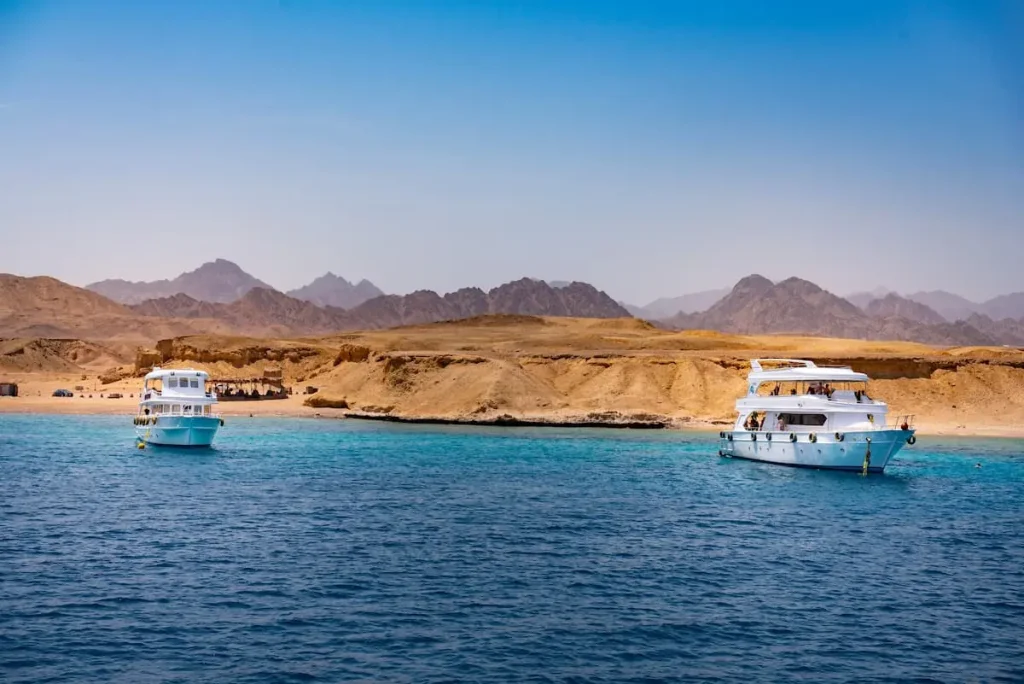
-
El Gouna – The Venice of the Red Sea
Referred to variously as the “Venice of the Red Sea,” El Gouna lies 25 kilometers north of Hurghada. This modern, purpose-built resort city boasts “city” lagoons, canals, and beaches, though made of golden sand.
El Gouna particularly fosters an activity, or rather, it offers activities, including the top Egyptian destinations for high-quality holiday experiences and water-related sports facilities provided. The current attraction here, as seen from classic kite courses to awesome dive sites in addition to preeminent championship golf courses and an expansive marina lined with many happening restaurants offering good services, is the integration of several new tourist excursions.
The Mediterranean, Nubian, and Modern styles of architecture blend into each for, blending into the aspects, though drawing further interest in the special and interesting yet spiritual colors that reflect the ambiance of this town. El Gouna it comes as a delight for couples, families, buddies, and solo travelers, inviting everyone to come up and enjoy the sunny weather year in and out, with nightlife accompanied by fantastic art festivals and various ecological projects.
El Gouna is not nearly as pretty as it is entertaining and welcoming. A place that offers fun and the company hoteliers do not miss out on. Whether one is interested in the experience of relaxation or wants to seek a little more flair, El Gouna surrounds the tourist with the most lovely of unforgettable vacations, where the Red Sea is involved.
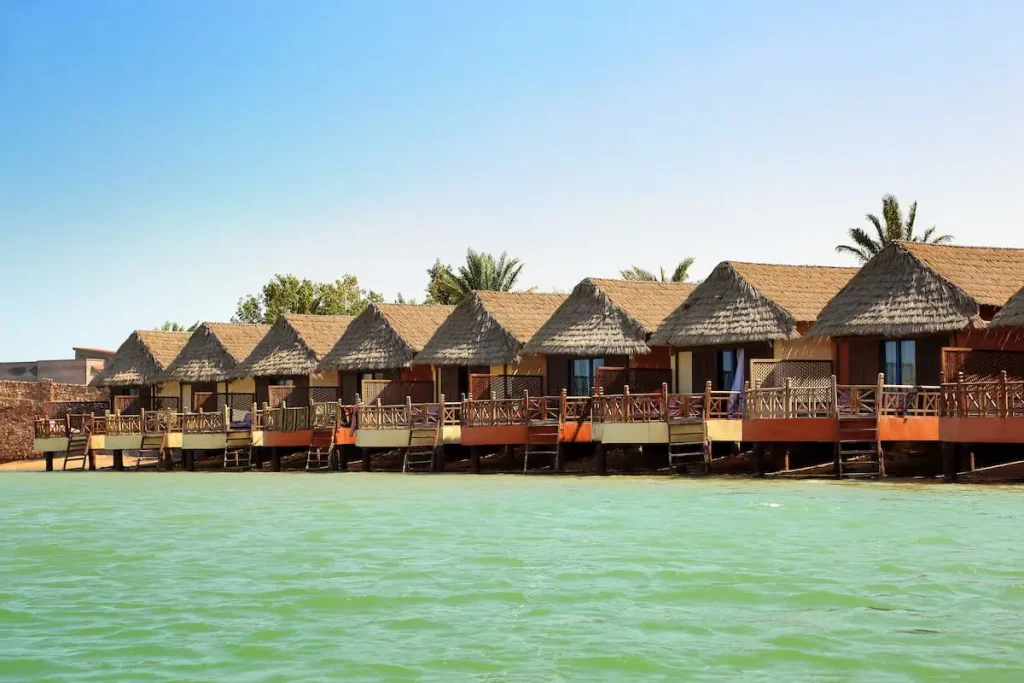
-
46- Alexandria Library (Bibliotheca Alexandrina)
This unique style of design also makes a truly cumbersome single piece of the architectural designs in order to make sure it survives its original ancestor, the ancient Library of Alexandria. Its archaism, the Bibliotheca Alexandrina, is almost a seduction for the would-be Patrons for Knowledge as it drives along the coast of the Mediterranean. It’s essentially the most vital structure built with the massive tilted roof, on which words of inscription have been carved in over 120 languages, right above it. The shape of the design is circular and suggests extremely eye-catching features of a mammoth stadium.
It was in the year 2002 when it was inaugurated that this library was first opened to the public and has since been added to one of the greatest collections of books anywhere, with its many specialized research centers, museums, art galleries, and the largest planetarium globally. It presents its culture, education, and dialogue activities on both national and international levels. There are reading rooms very large, perhaps bigger than anybody’s eye has ever found anywhere in the city. Education and scholarly learning would be entered in their proper frames. International traveling exhibitions or permanent displays are based on science and history, not forgetting the arts.
Today, the Bibliotheca Alexandrina is extending the age-old philosophy, continuing with its old predecessor to bring to life ancient events in connection with the modern world, to protect human knowledge, and light up the future. A library where one can get a visit and that is especially for history lovers, scholars, and architectural admirers, too, from all walks of life.
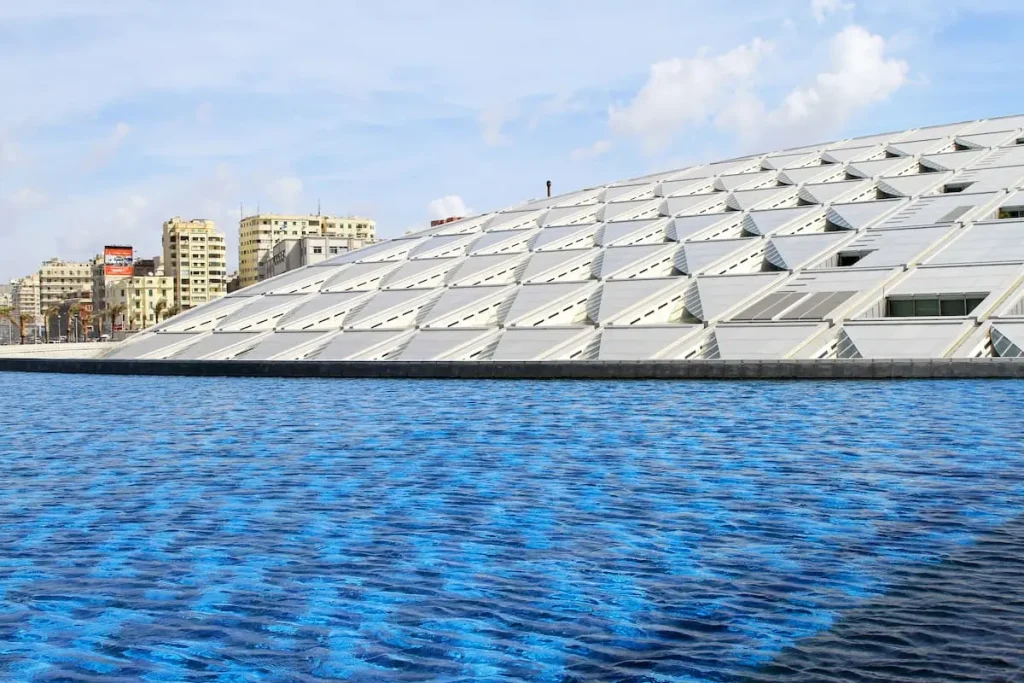
-
47- Qaitbay Citadel
It was in 1477 that Sultan Al-Ashraf Sayf al-Din Qaitbay laid out the Qaitbay Citadel, where it now stands on the Mediterranean shore of Alexandria. It was built right where the ancient Lighthouse of Alexandria had been, once one of the seven wonders of the ancient world, protruding outwards into the sea. This monument was made to be a firsthand line of defense against enemy fleets aiming to take control of Egypt’s northern coast.
Here you may feast your eyes on tremendous walls made of stone, on large constructed walls and towers, and inner courtyards. Survey the view of the sea and city. You will take your tour inside it, as there are the historic chambers, exhibitions, and presentations on Alexandria’s maritime heritage.
Those who visit Qaitbay Citadel would be in awe of not only ancient history and ambience but also one of the best settings to capture memorable and attractive photos. It is Alexandria’s iconic landmark, reminding current visitors of centuries of naval history as well as an untold fighting tradition on the coast.
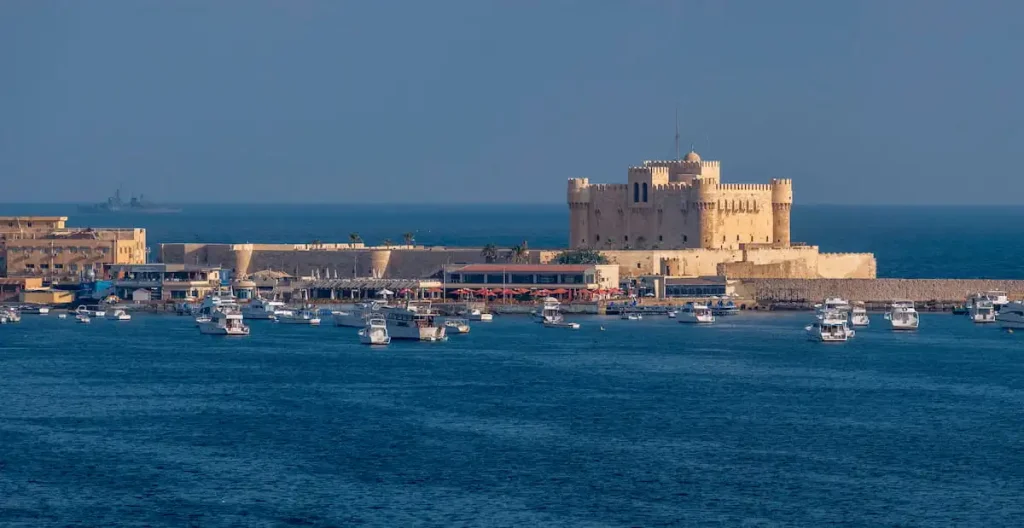
-
48- Montaza Palace
Overall, the Montaza Palace depicted a fusion of the east and west, its royal grandeur basking in composite verandahs, while the backyard had a cool Mediterranean charm. It was built in 1892 by Khedive Abbas II to serve as an Ottoman-style summer house combining thematic elements of Italy’s Florence, aged by centuries of rust, creating quite an inviting space.
The beauties of nature interconnected a total of 150 acres of garden from palm tree to palm tree. The sense of walking through a beautiful garden under oil palms and spruces, accompanied by shining white roses, knows no variations. The beautiful views of the sea or trips along the beachfront, even under the shade of the umbrella pine, are likely to be advantageous for those times.
While many people cannot enter the palace, for only a short period at some part of the day, they can roam in the garden or its surroundings away from their limited abodes, together with men and women sightseeing in shorts, rubbing sunscreen into each other’s backs, and lovers holding hands. Partisans of the last couple took pleasure in spraying themselves with orange water to make things perfect.
Towards the eastern fringe location of Alexandria stands the Montaza Palace, a grand edifice of royal grandeur in the midst of soft gardens with the Mediterranean Sea lying just in front. It was constructed as a country retreat by Khedive Abbas II in 1892, and its residence has varied in terms of architectural style, combining the Ottoman and Italian approaches to building, and yet this house has its own peculiar style of a strong personality.
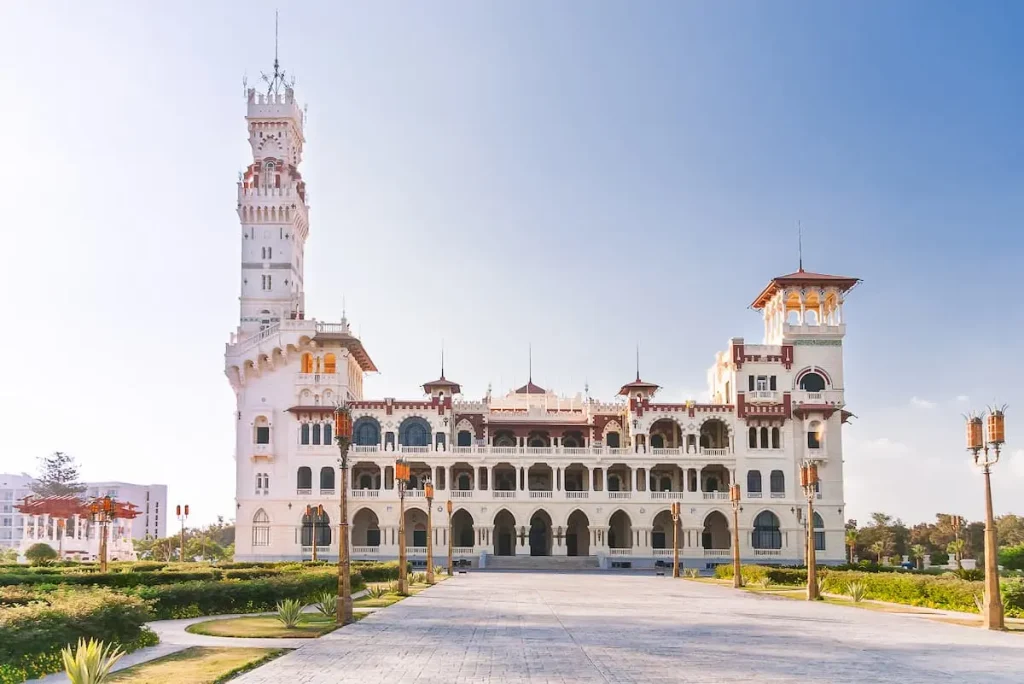
-
49- El Alamein War Memorials
The morphological features of the war memorial at El Alamein run down the north coast of Egypt; the monuments mark what was arguably the most critical battle of World War II. The Battle of El Alamein, which took place in 1942, was the decisive moment in the North African Campaign, halting the Axis force at the door of Egypt. Today, the site is used as a silent tribute to all Allied soldiers from every nation who fought here and who are resting here.
It also includes the Commonwealth War Graves Commission cemetery, a field of white headstones in row upon a row; a memorial of the soldiers of the world, the German War Memorial, stark yet moving; and the Italian Memorial, erected fortress-like on top of the sea overlooking the land. Military Museum El Alamein is not a long drive from there; it contains descriptive statements with photographs and battlefield artifacts.
The war memorial in El Alamein thus builds history for weeping and moments upon which the most baffling introspection could be built about human values.


